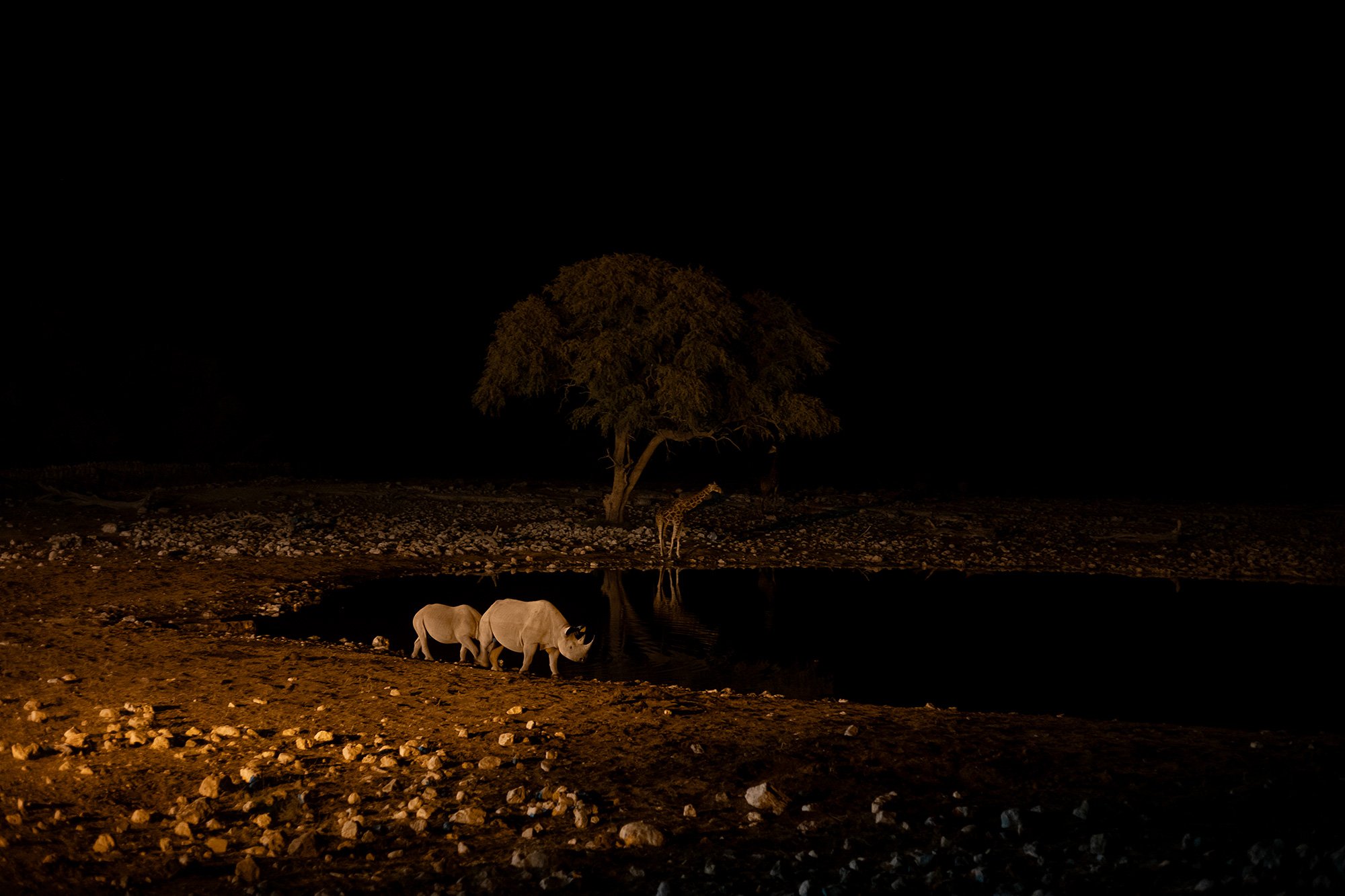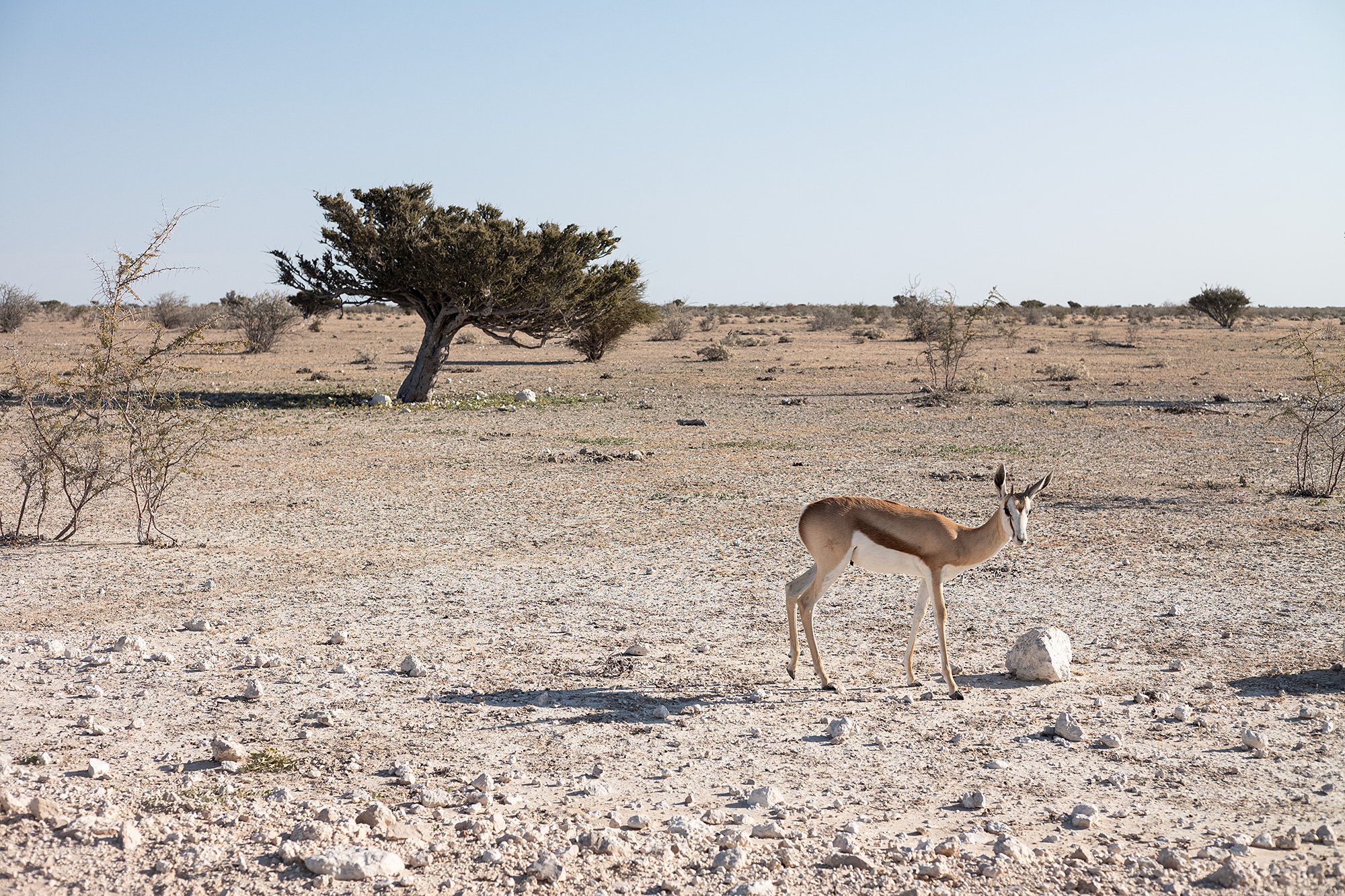
Namibia chapter twenty-three
Dolomite Camp to Okaukuejo, Etosha National Park.
Mack picks me up at the entrance to my tent in the morning. Not only has he come to fetch me, he’s also taking us on a morning game drive.
He takes us in the golf cart down to the Landcruiser and we bundle up for the drive. It’s cold and dark as we head out to the Dolomite waterhole, just below camp. I’m dressed in layers and wrapped in a blanket and yet the cold penetrates.
The waterhole is empty. Mack pauses for a moment, debating whether it’s worth waiting to see if any will emerge. He decides to try somewhere else and we head back in the direction of the main gate before taking a right towards another waterhole.
We’re immediately rewarded with the sight of four lions lying beside each other on the side of the road. He stops to let us observe and take photos and I completely miss the fact that many more are lingering around the watering hole.
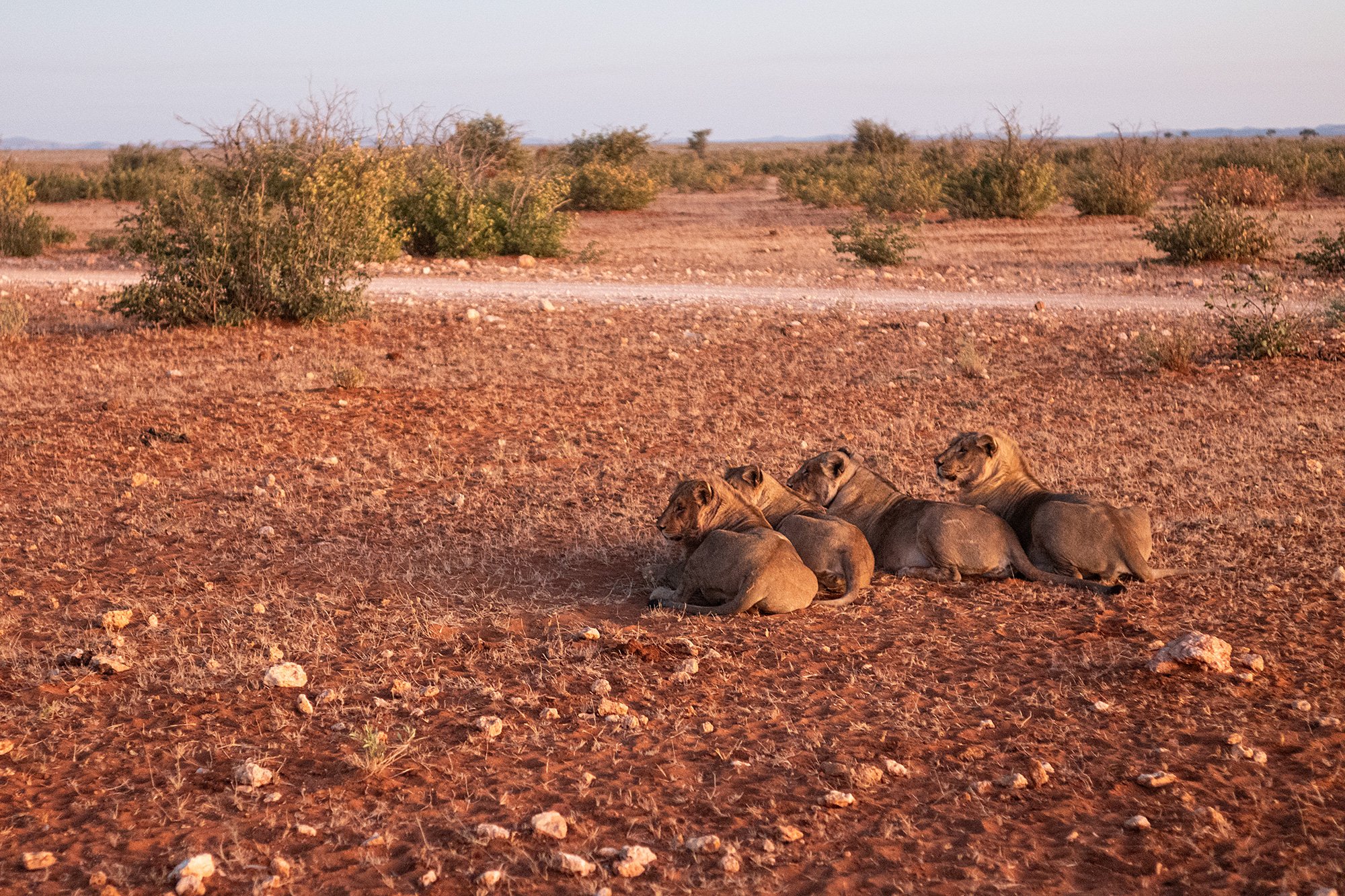



Mack pulls ahead so we can have a better view of the lions before us. One peels itself away from the others and approaches the vehicle, curiously circling it, pausing now and again to consider a certain angle. Mack tells us he’s never seen this behavior in a lion and starts and revs the engine to show dominance. The lion lopes back to their group.
In total we see eleven lions at the waterhole, collected in a few groups. After drinking their fill, one main group gathers together a few smaller groups together and stars heading into the bush. The younger lions jump playfully over each other as they walk toawrds the west.
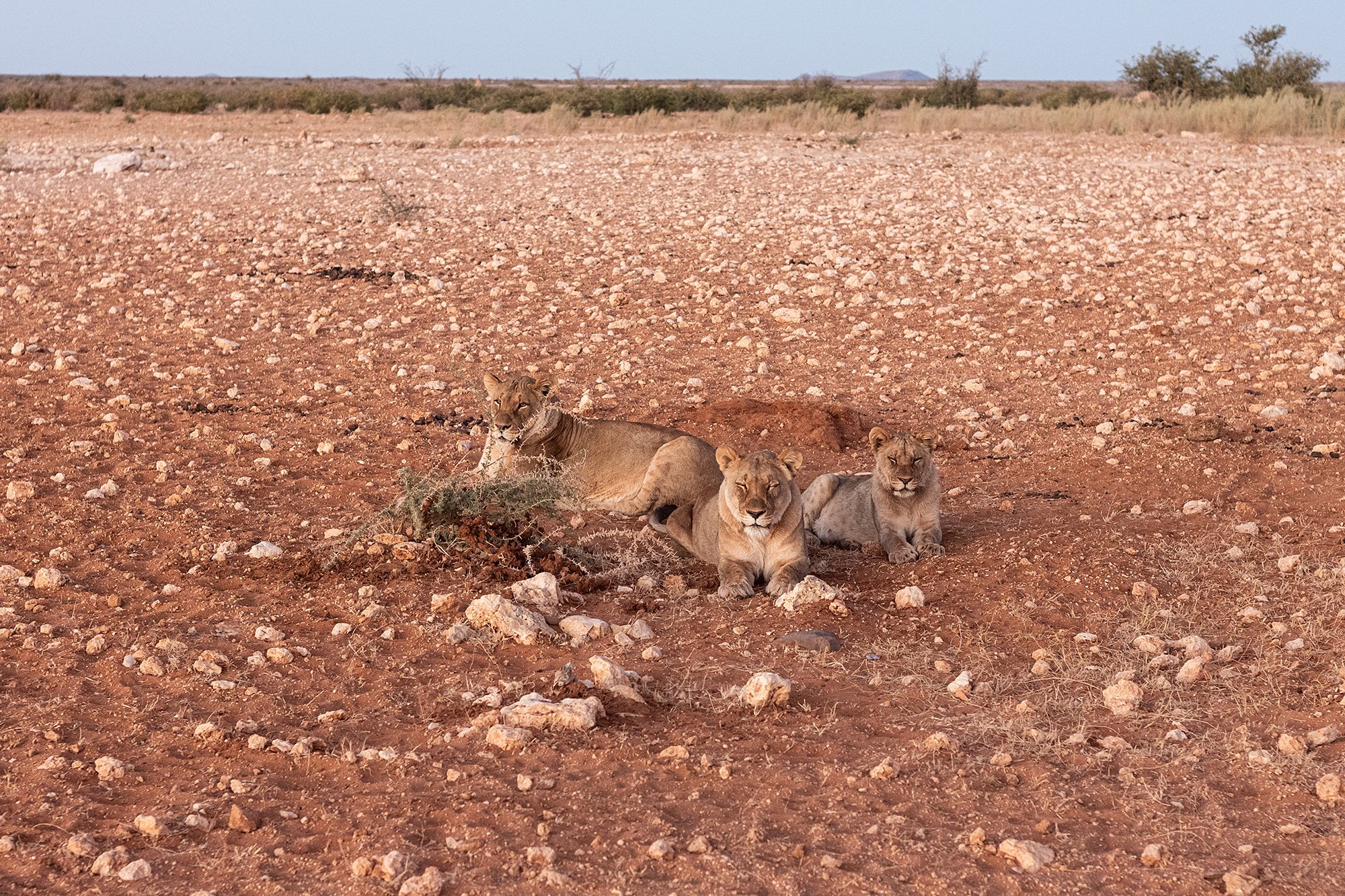
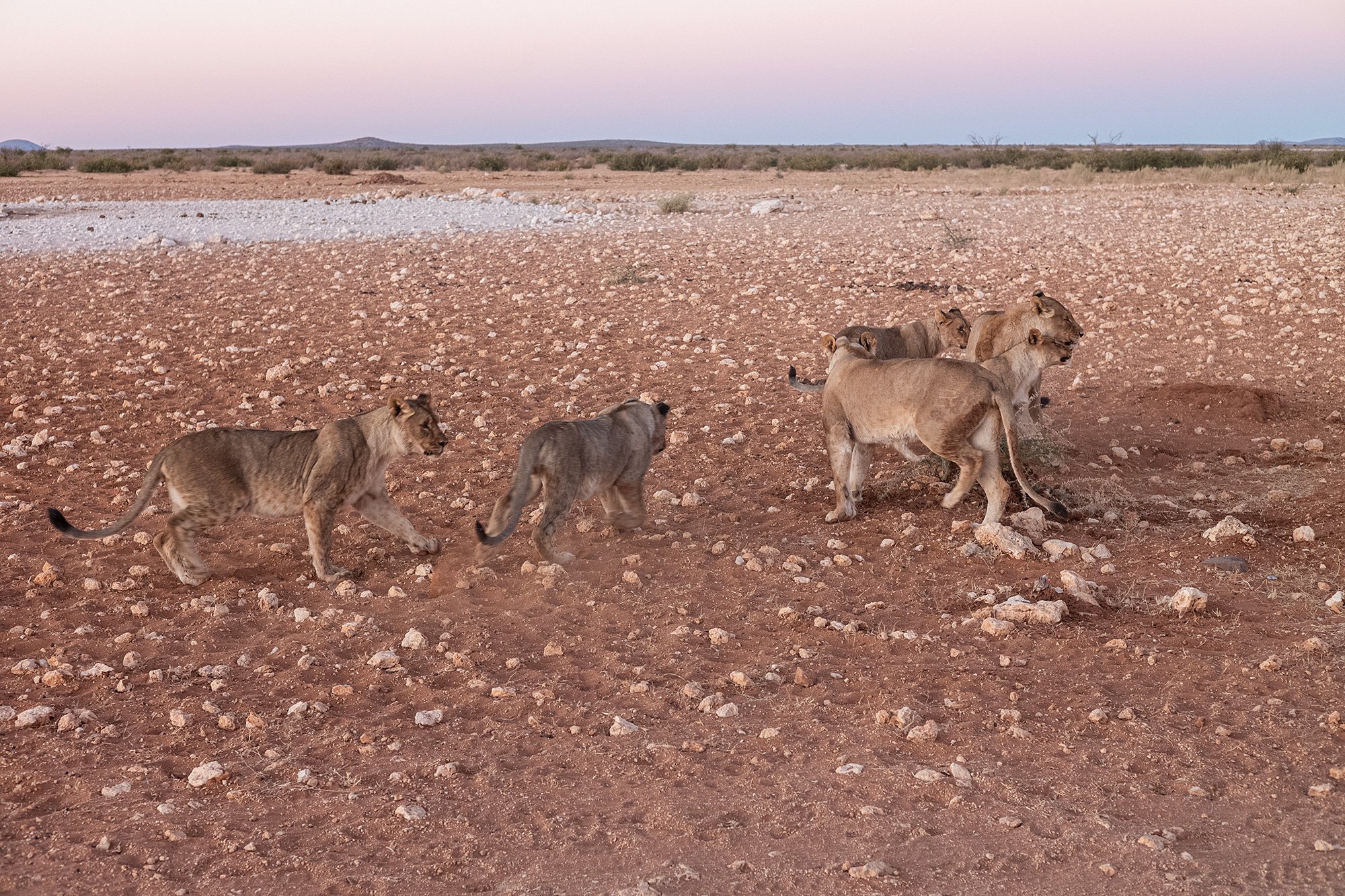
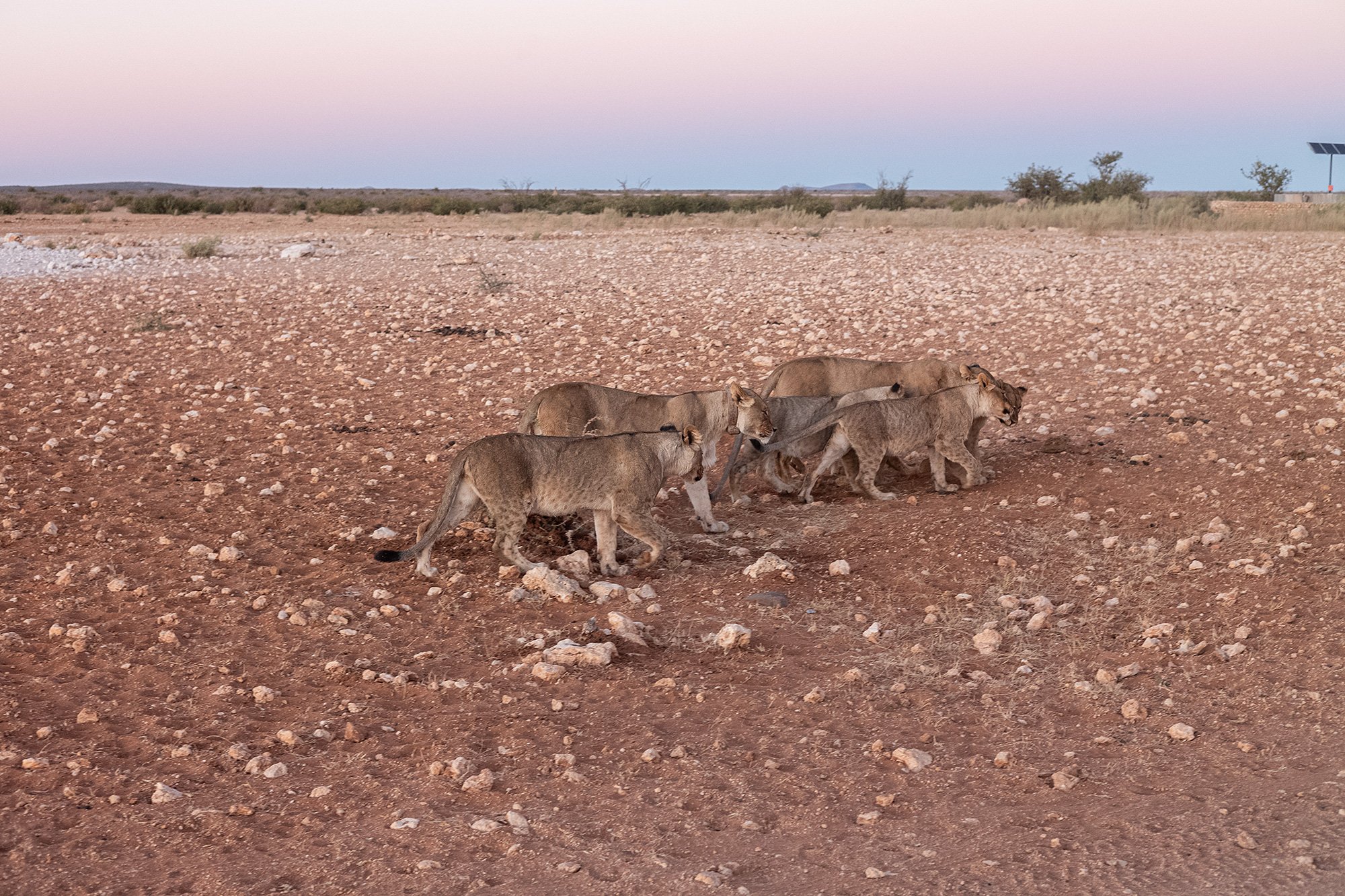

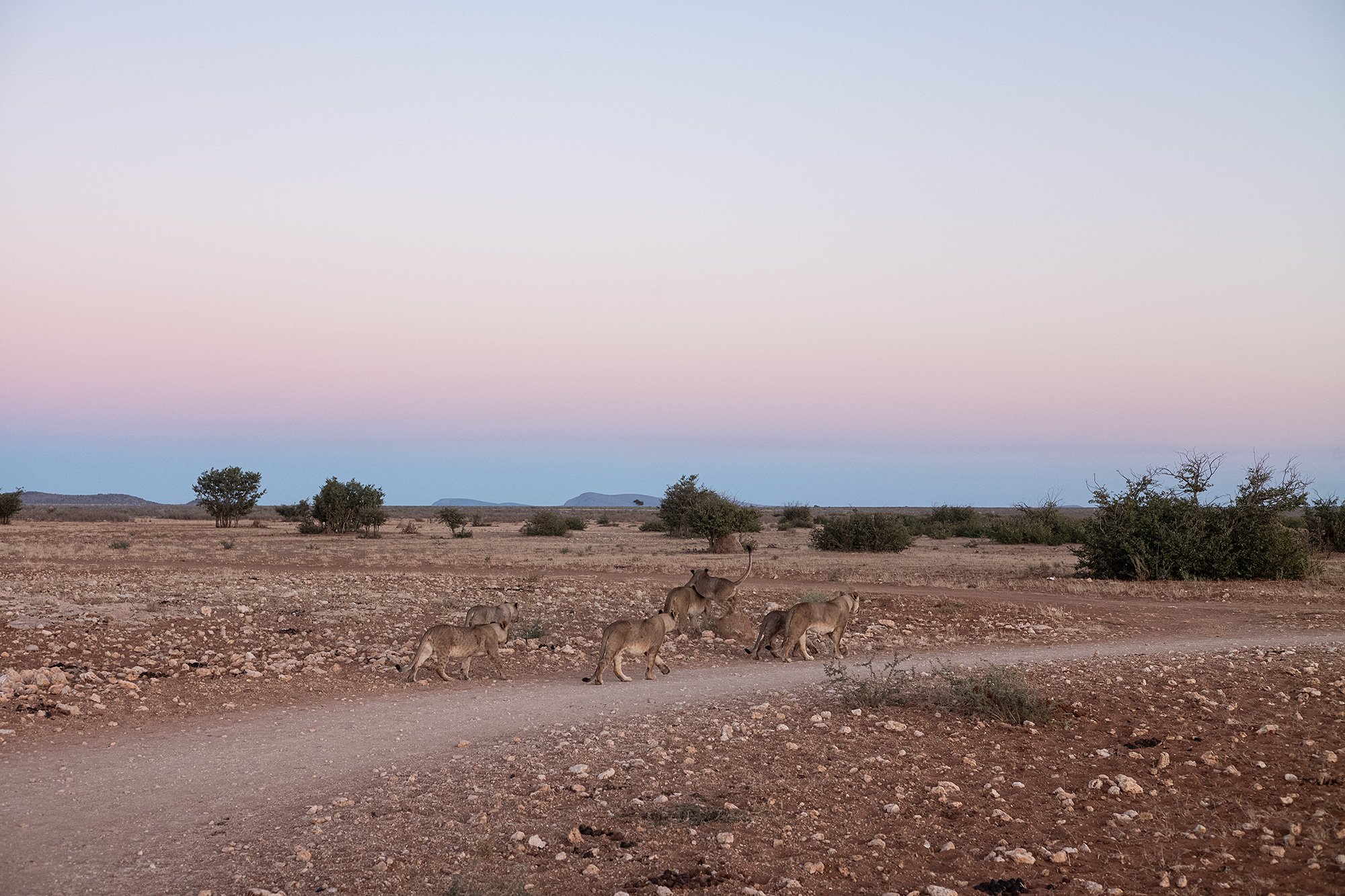
We follow them as far as the road allows. When we’re close, one turns to look at as and back at the group of four that continue to lie where we first found them before turning around and re-joining the others.
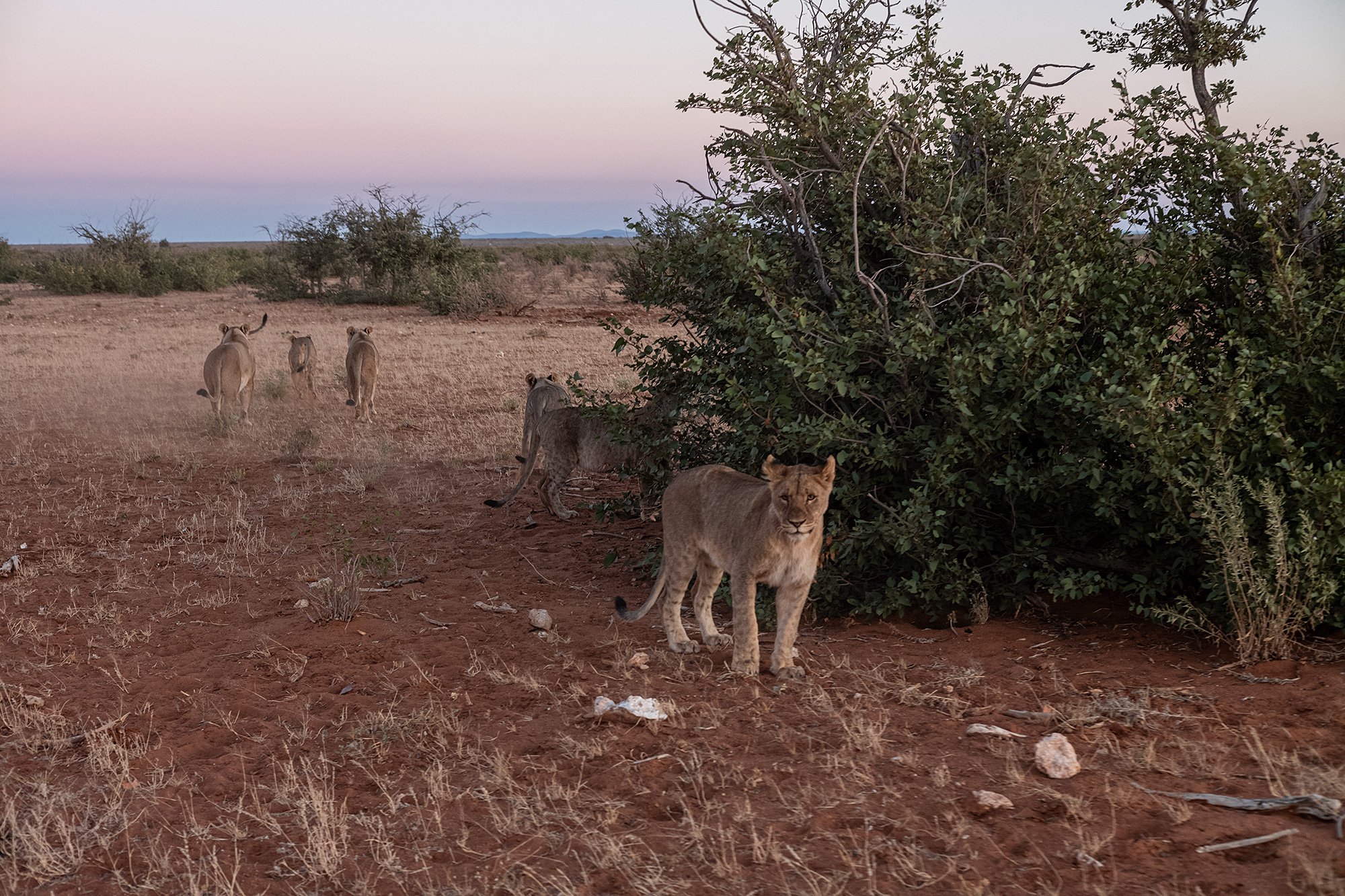
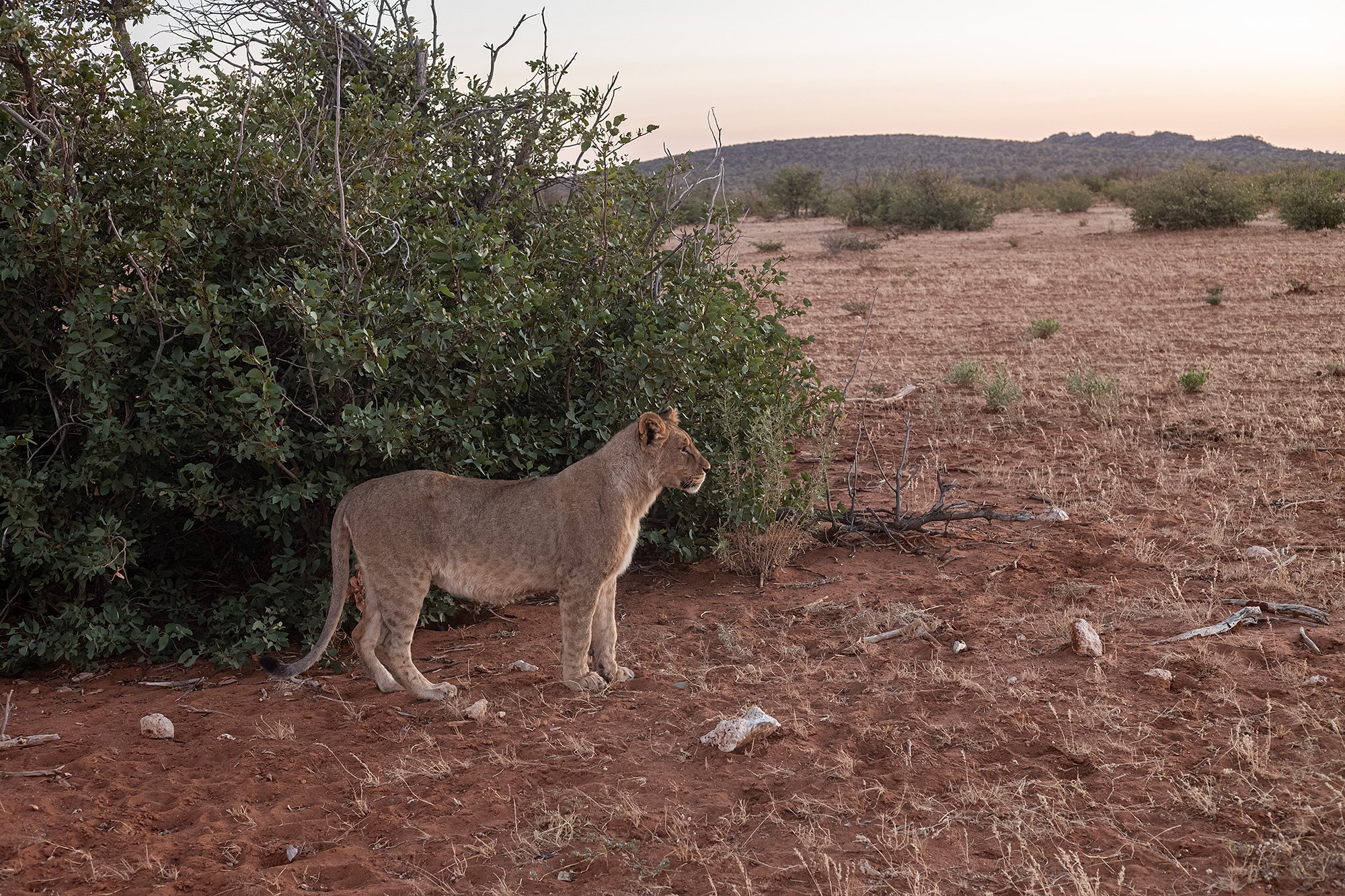
As we leave the waterhole Mack pauses once more by the four lions lying on the plains. They’ve not moved in all the time we’ve been there. He tells us that this pride of lions hang out in this area and can often be seen at the waterhole. He also tells us about some of the other animals in the area, including the mountain zebra, which can only be found in this part of Etosha. He tells us that they can be identified as separate from plains zebra by their “socks.”
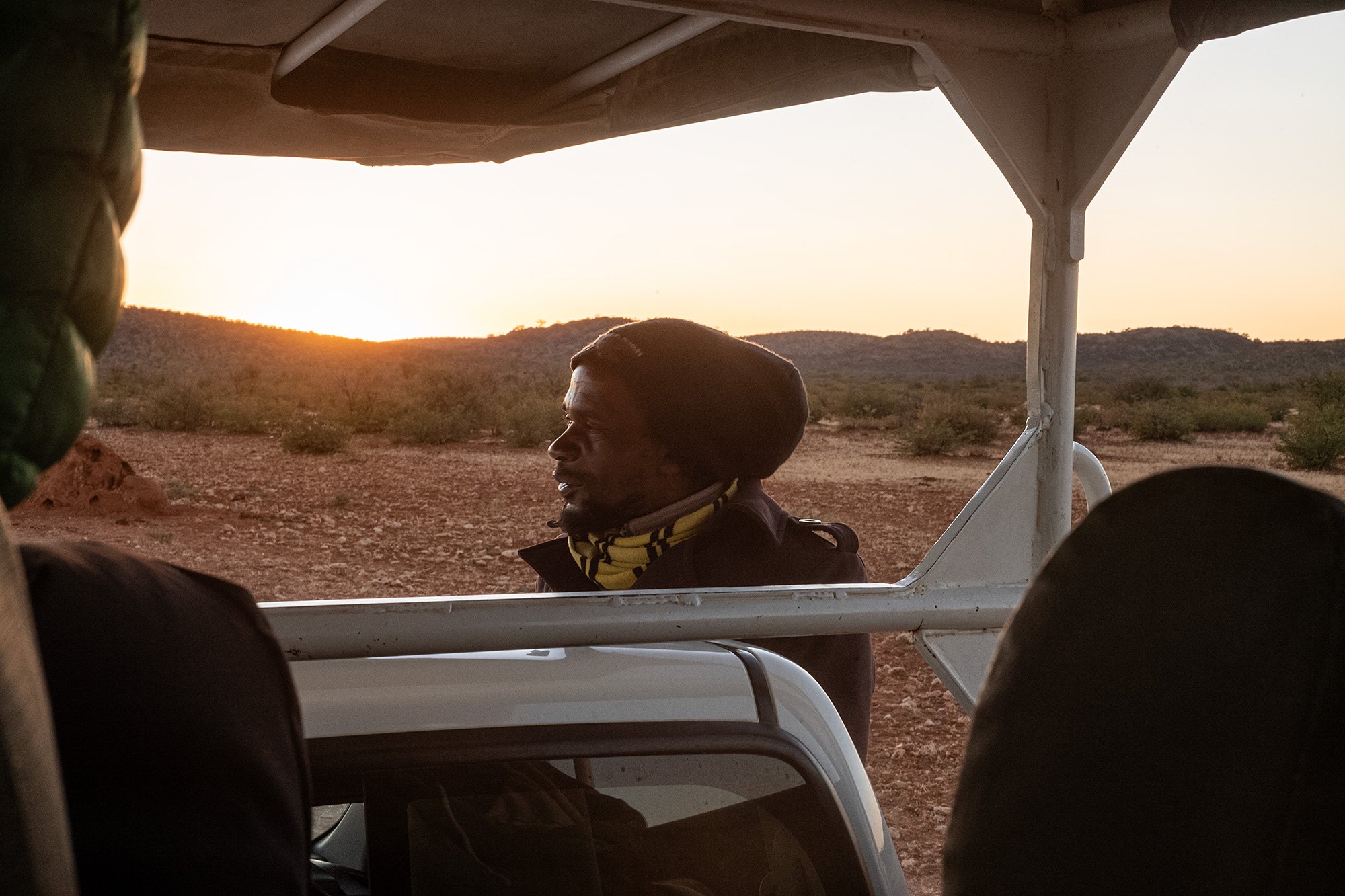

On our way back to the camp we spot kori bustard—the largest flying bird native to Africa, a large herd of springbok, ostrich, and guineafowl (one of my favorite birds to spot for their flat, trapezoidal shape).
Mack tells us stories and jokes about the guineafowl. He tells us that if you make a stew with rocks and guineafowl, the rocks will be more tender. He also tells us to be careful when driving by them. When startled, they can fly up into the windshield, breaking it. He also tells us they’re nature’s alarm call; if they spot predators they make a lot of noise, warning other animals of their presence.
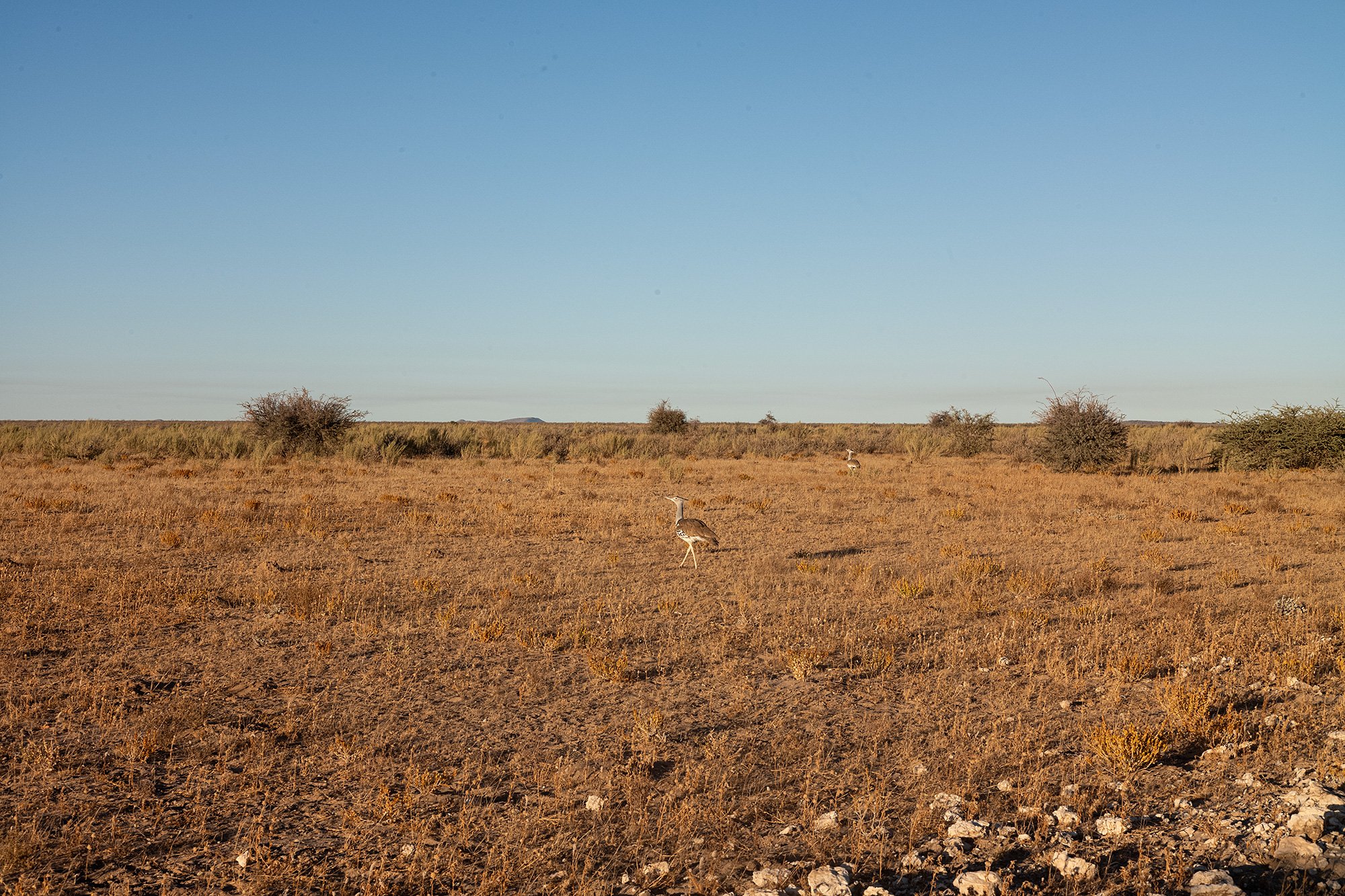
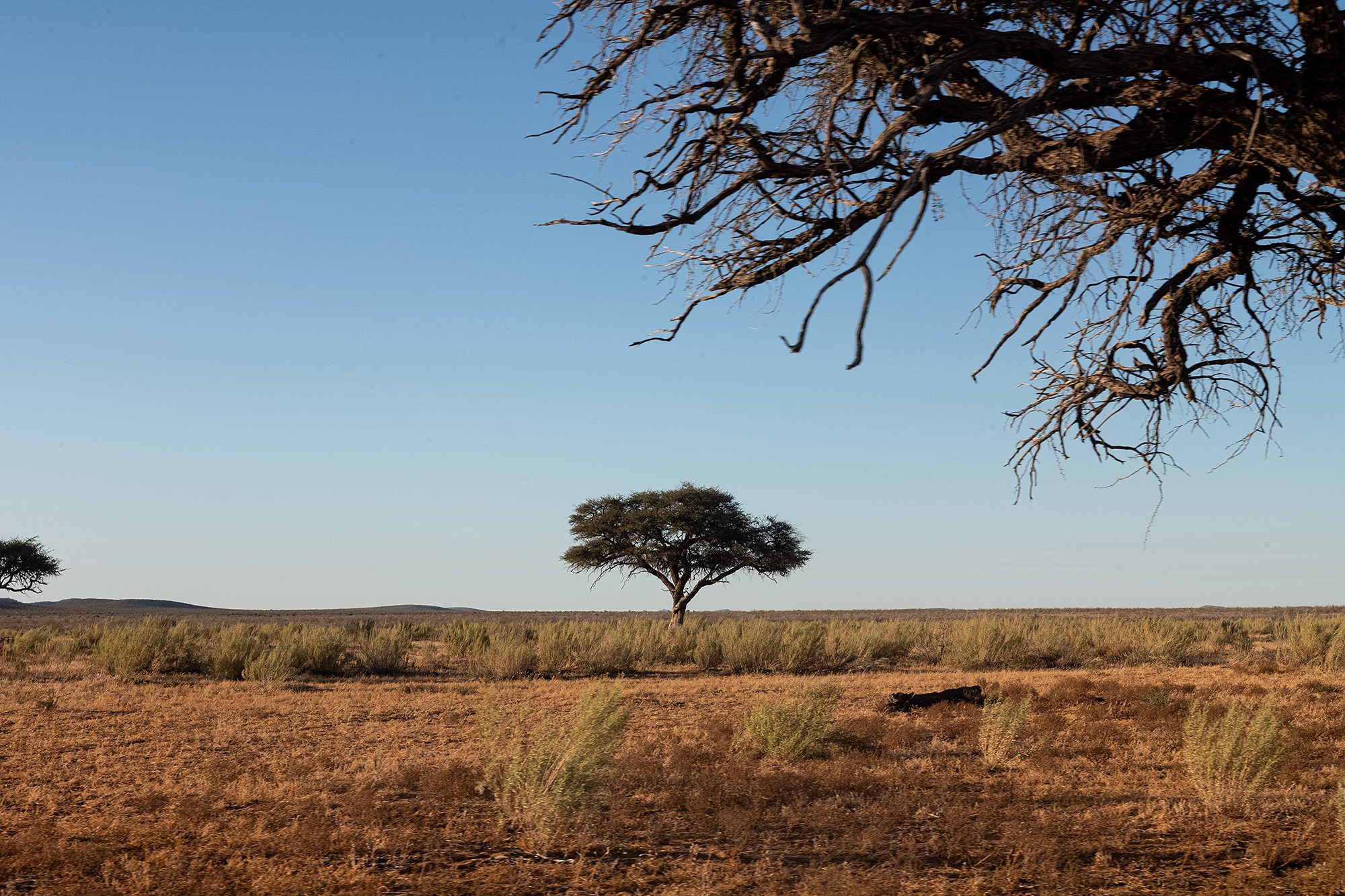

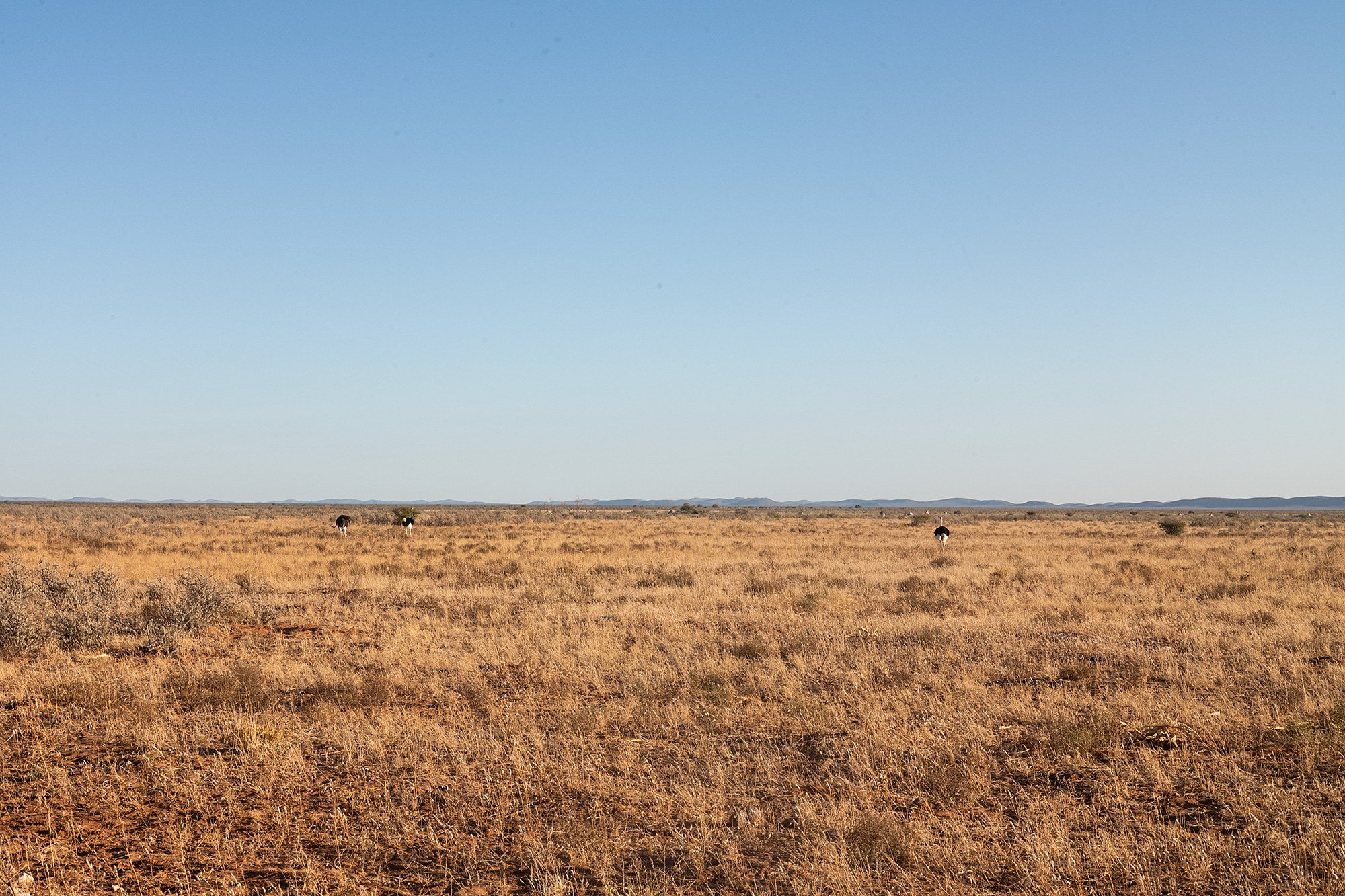
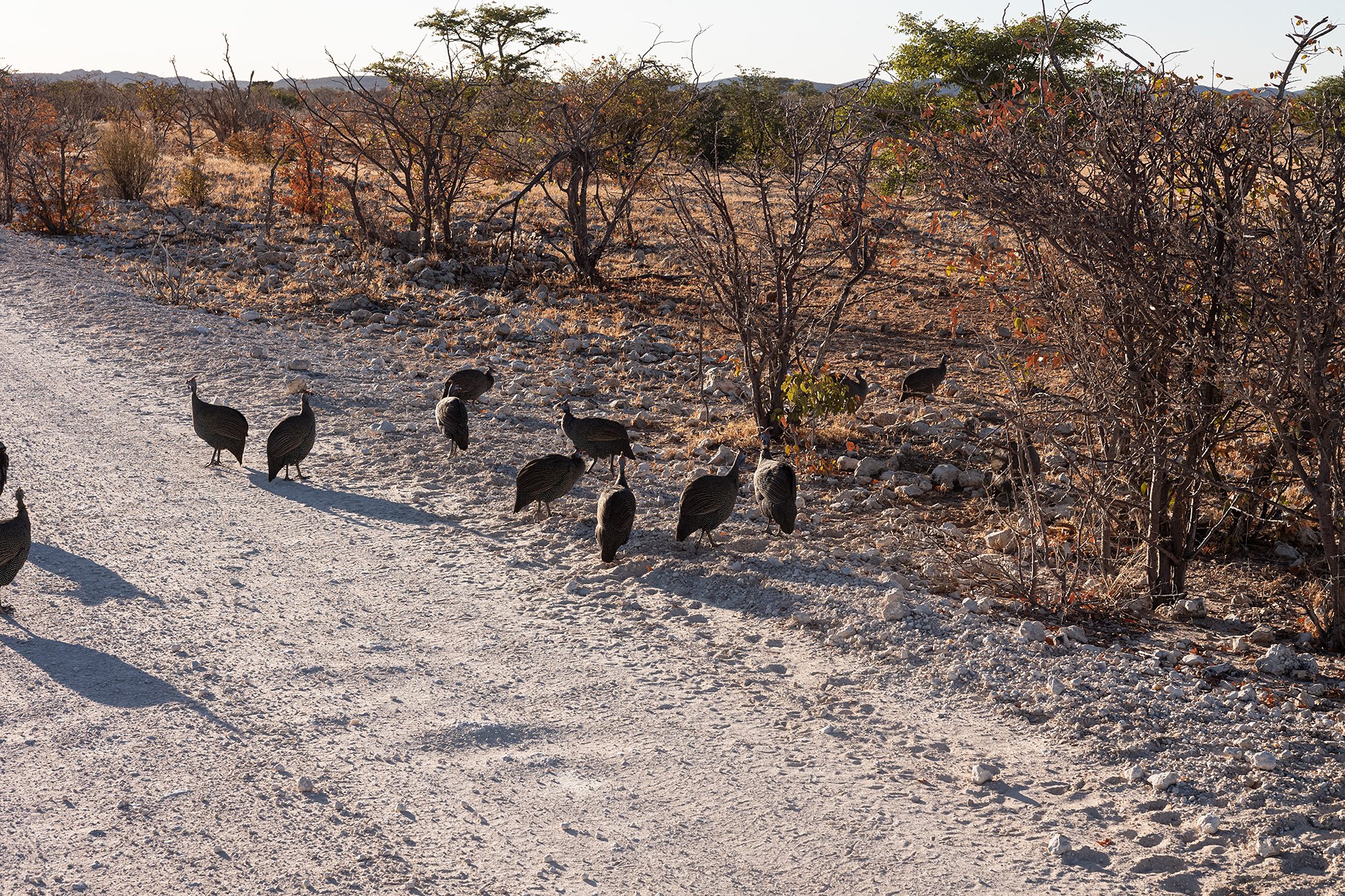
Back at camp I settle in for breakfast. The French couple asks how the drive was and I tell them about the lions. They ask where the wateringhole is and I’m happy to provide directions in hopes the lions return. I wish them luck in their sightings and in their travels.
Mack tells me I can relax and don’t need to rush to continue safari today as I’ve spend the early morning out in the bush. But I’m planning on driving to Okaukuejo in the center of the park, hitting as many waterholes as I can. I ask Mack his recommendation and he names a few. He tells me that most of them are visible from the main road. I can look over while driving by to see if there are animals and then judge whether it’s worth making the detour.
After breakfast we arrange a time for him to pick me up to drive me back to my car. After packing up my things I take one last look out at the view. A wind has picked up casting dust across the plains.
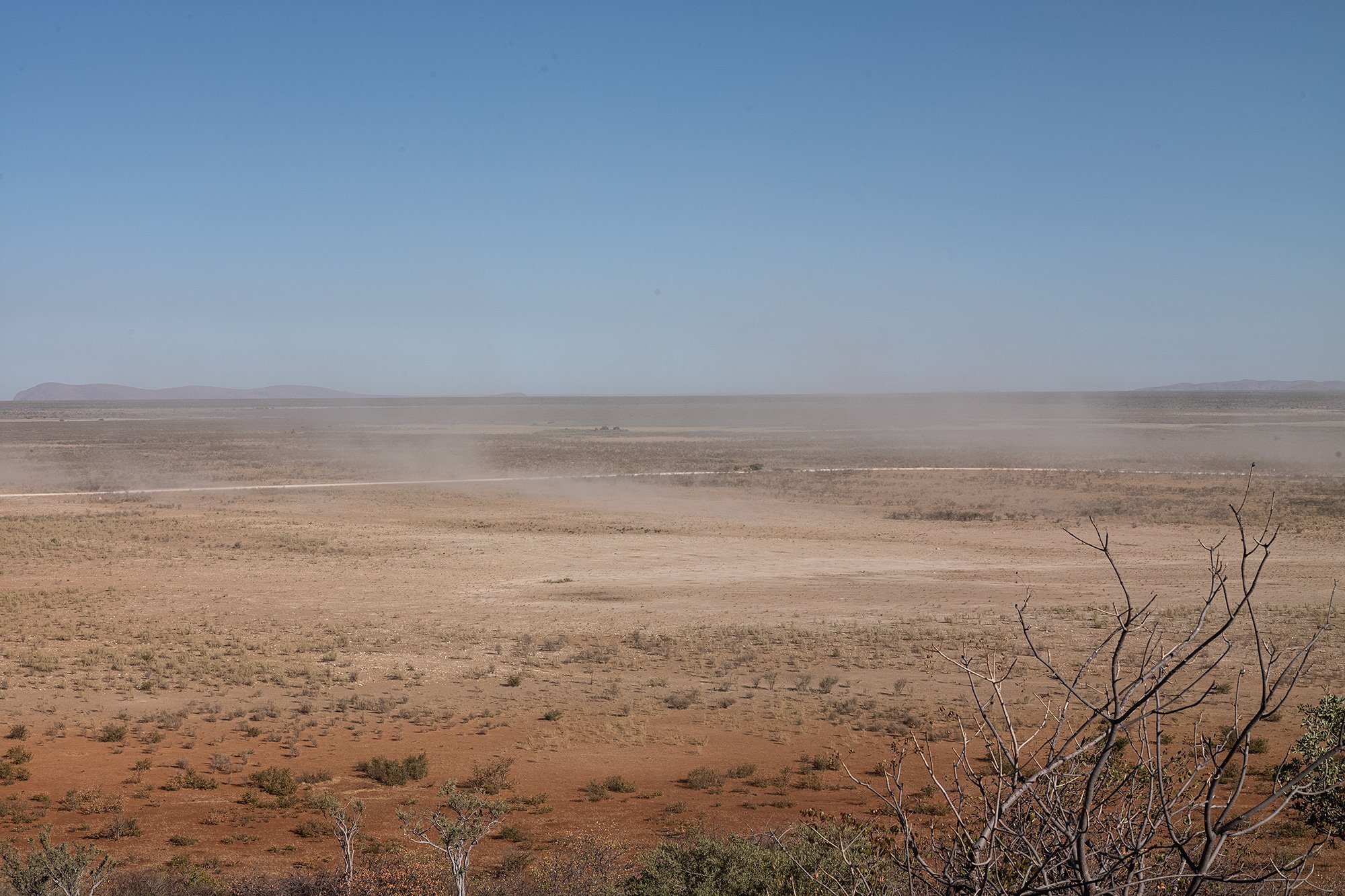
I load my bags into the Hilux and bid Mack adieu. It’s still cool out and I leave my windows closed as I head to the main road and back to the Dolomite waterhole to see what I might catch there before continuing on through the park.
Along the way I pause to watch a pair of jackals as they stroll alongside the road. Nearing the waterhole I spot a herd of ostrich and a herd of zebra being blown about in the winds. The ostrich run upon seeing me but then gather a short distance away, ghostly in the dust clouds whipped up by the wind and their activity.
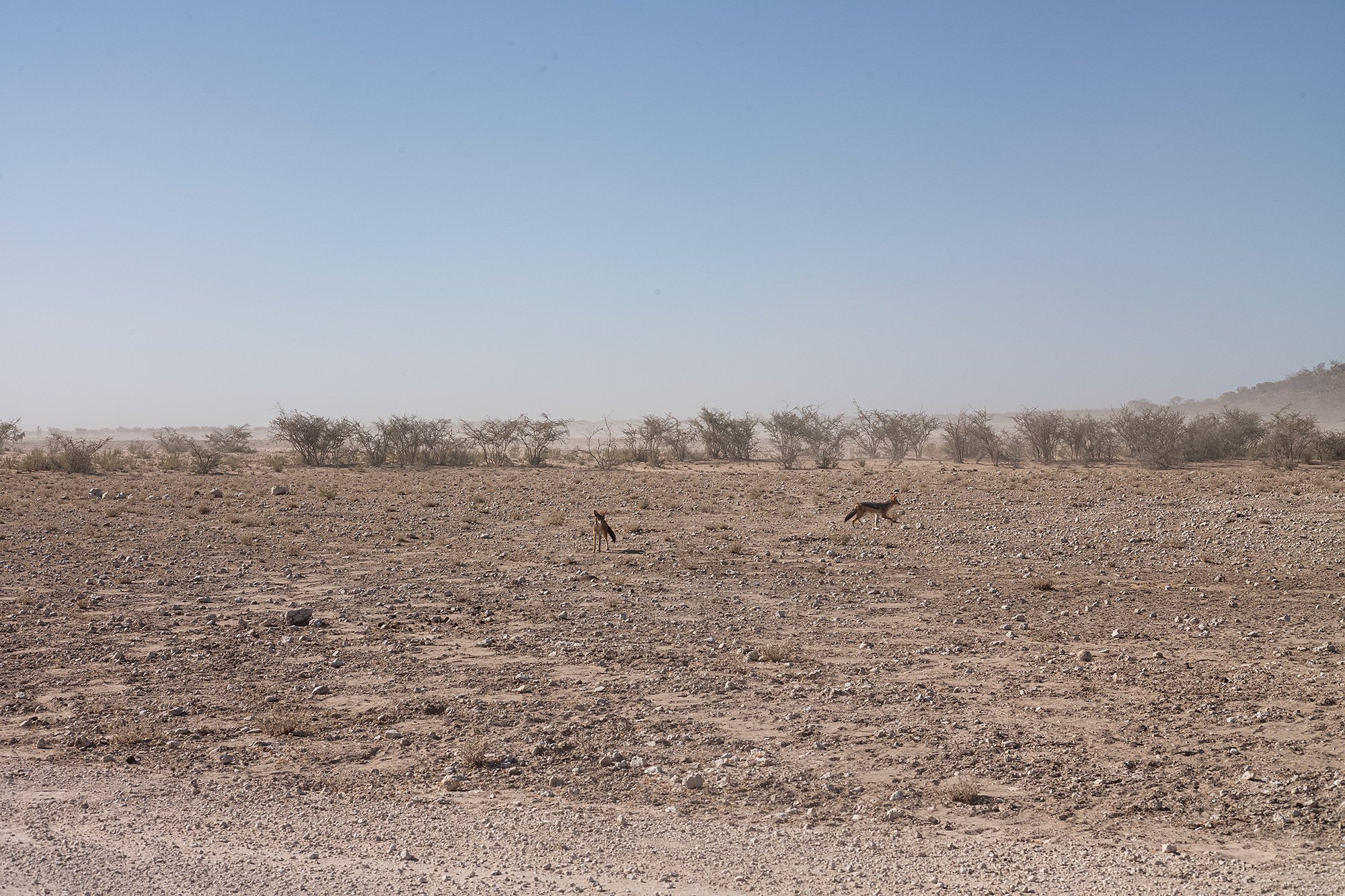

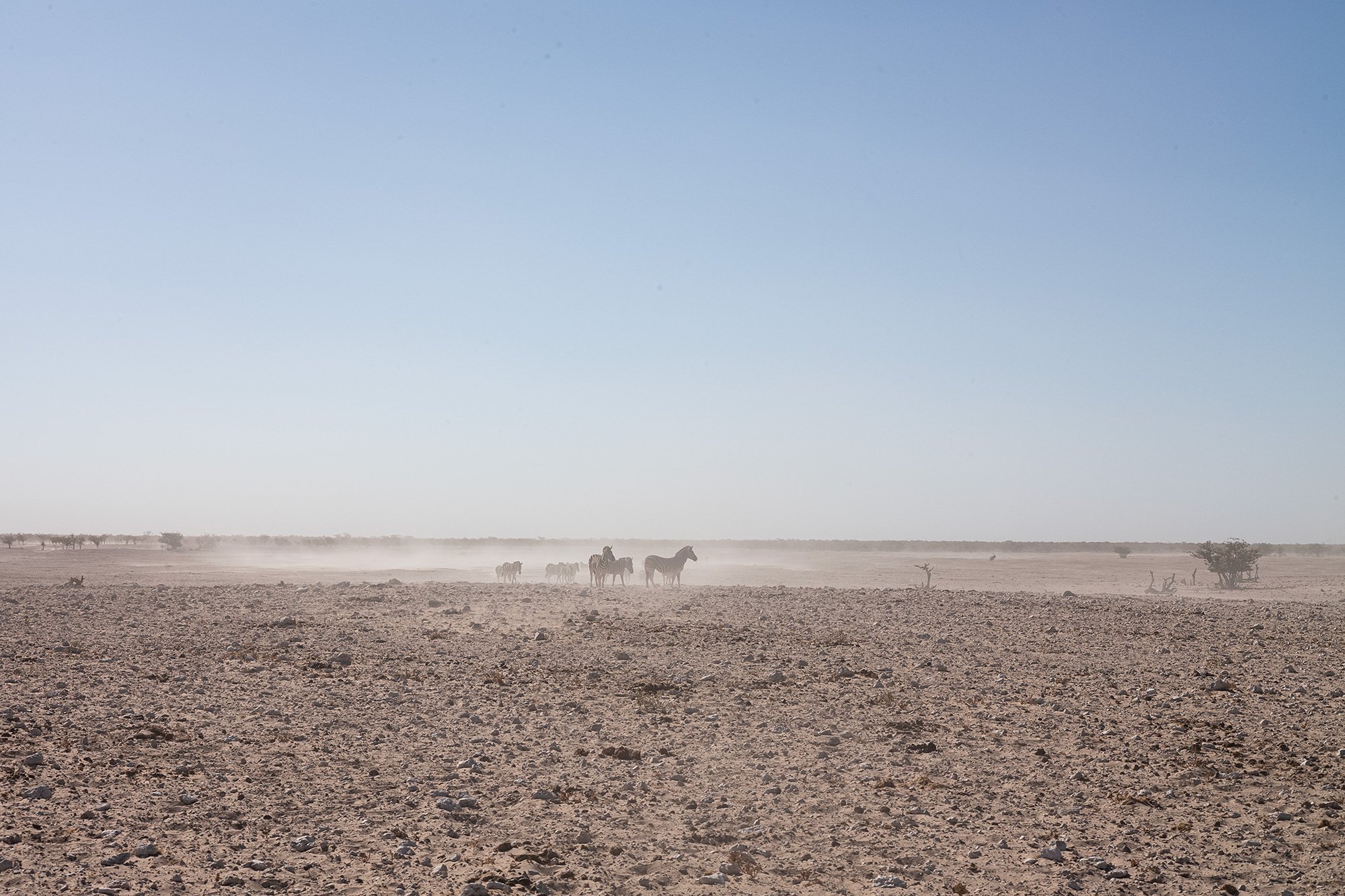
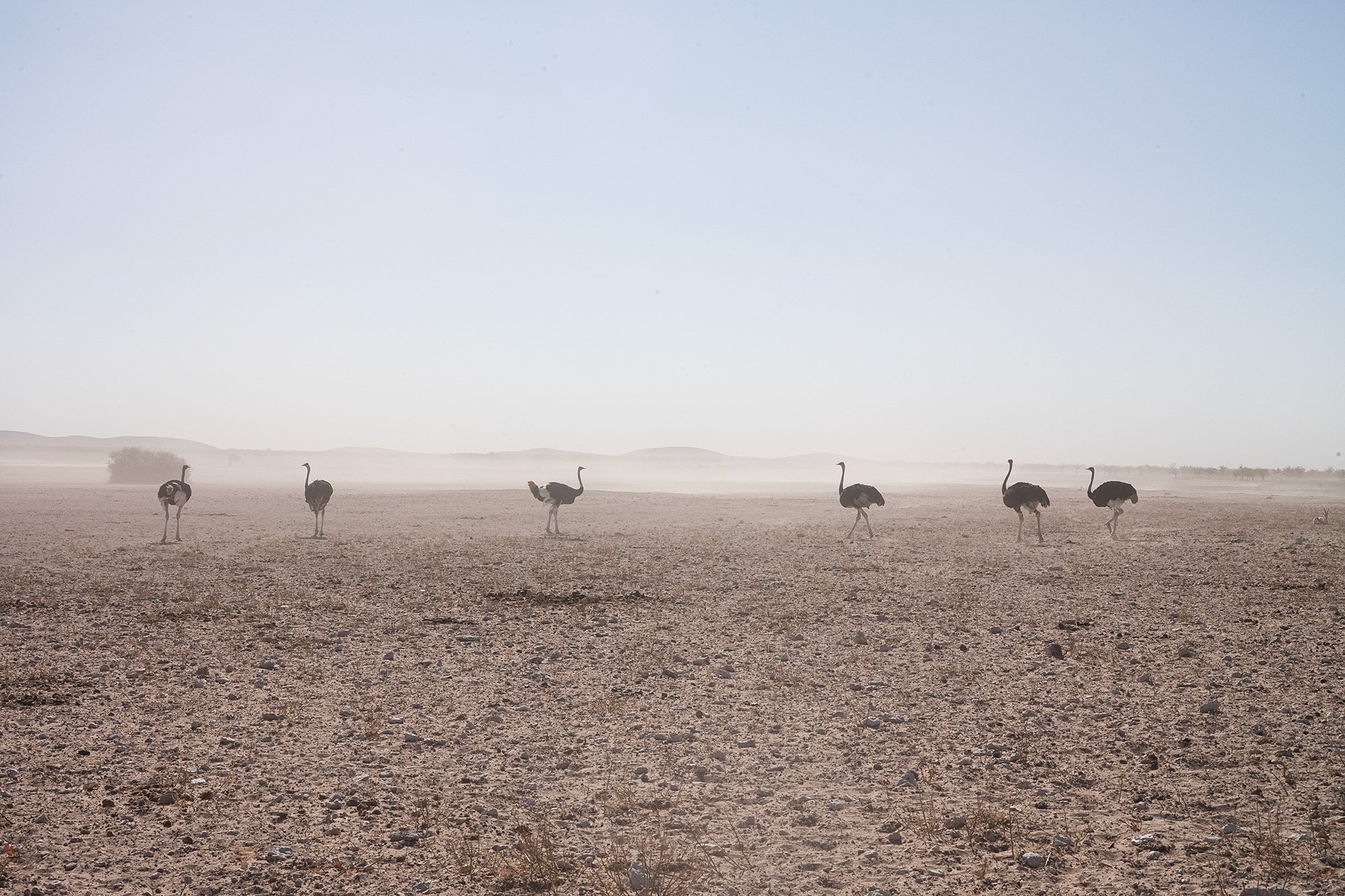
Leaving the waterhole I head back to the main road and head east. Rounding a bend the wind and dust settle. The skies clear and the ground glows yellow with grass. I settle in for the drive to the next waterhole when I spot a lone elephant by the side of the road. I stop and roll down my windows to admire them as it feeds on the leaves of the trees around them.
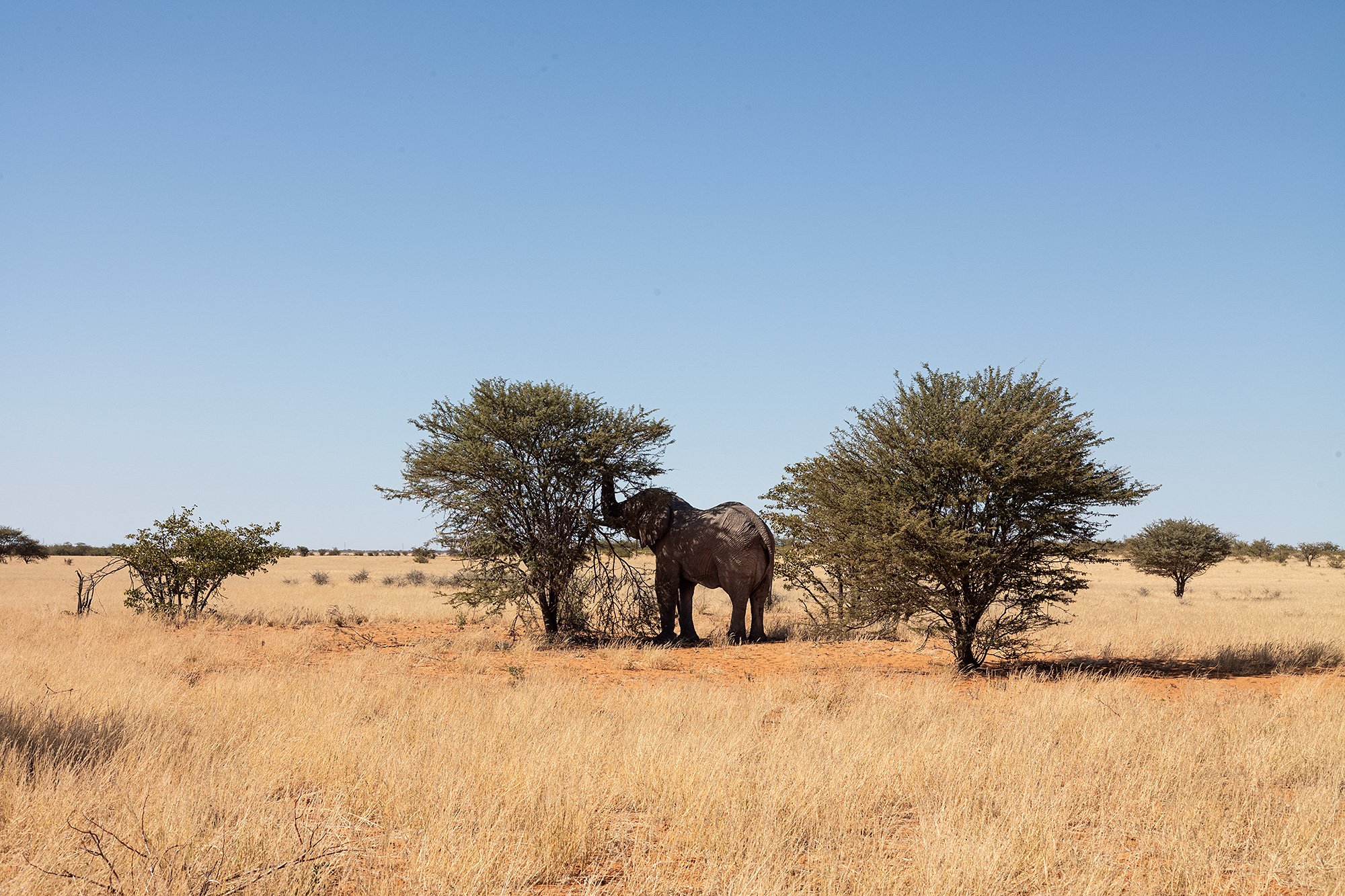
As with almost all elephants, I could watch forever. But the day isn’t going to wait for me and I have a long way to go before I reach the next waterhole.
I’m taking the northern route from camp, which means I’ll be missing a few of the waterhole to the south and a natural spring, but it’s impossible to see them all and make it to Okaukuejo. It’s also luck of the draw with respect to where the animals are and which will reveal themselves. When safari guides ask me what I want to see I tell them I’m happy just to be in the bush.
I stop at the Duineveld and Nomab waterholes. Zebra and wildebeest and gemsbok hover near the former. At the latter I spot a lone jackal trotting around the hole. From there I spot a red hartebeest and springbok before seeing another herd of zebra. Between some bushes I see a young zebra suckling from its mother’s teet.


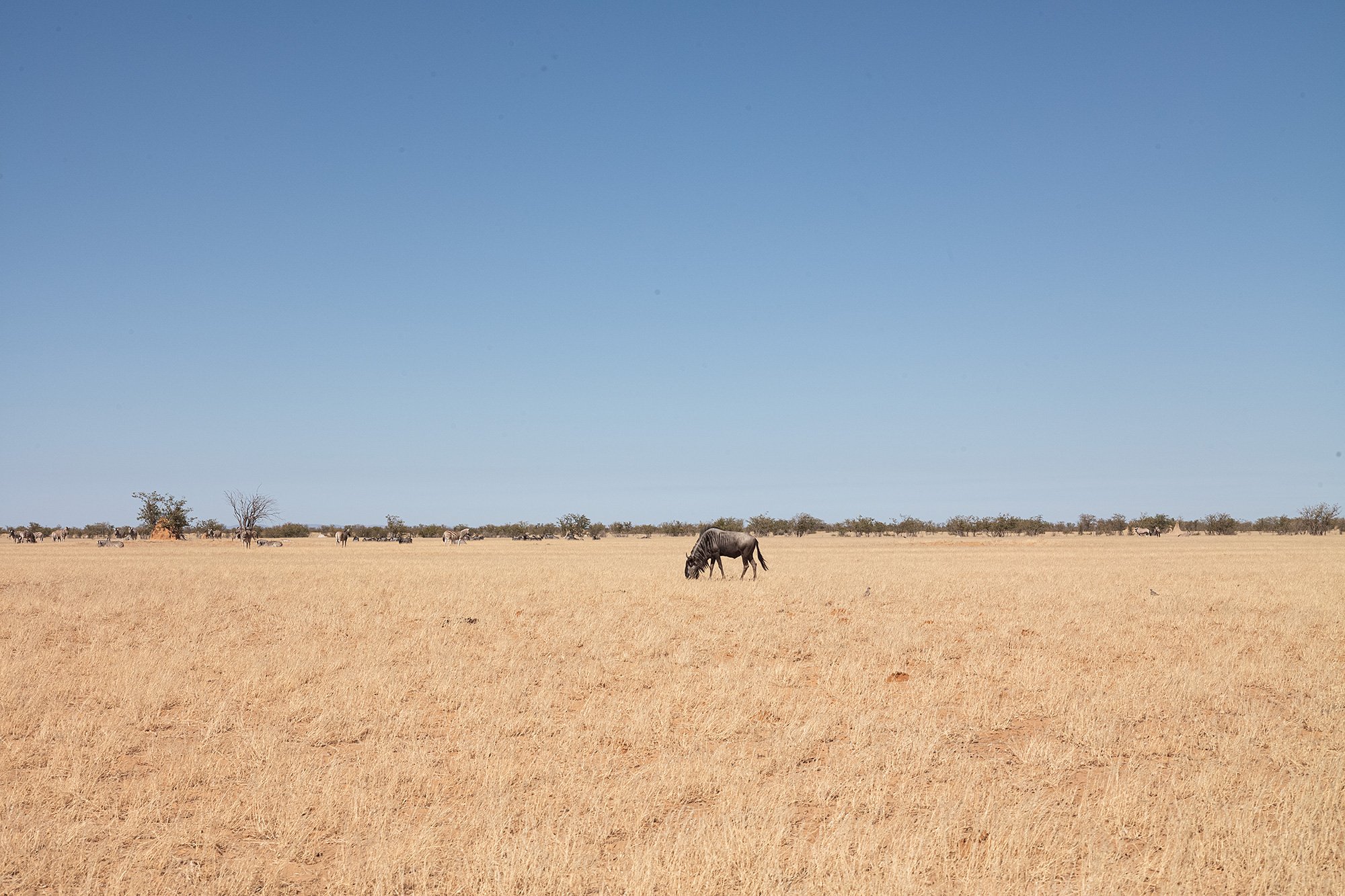

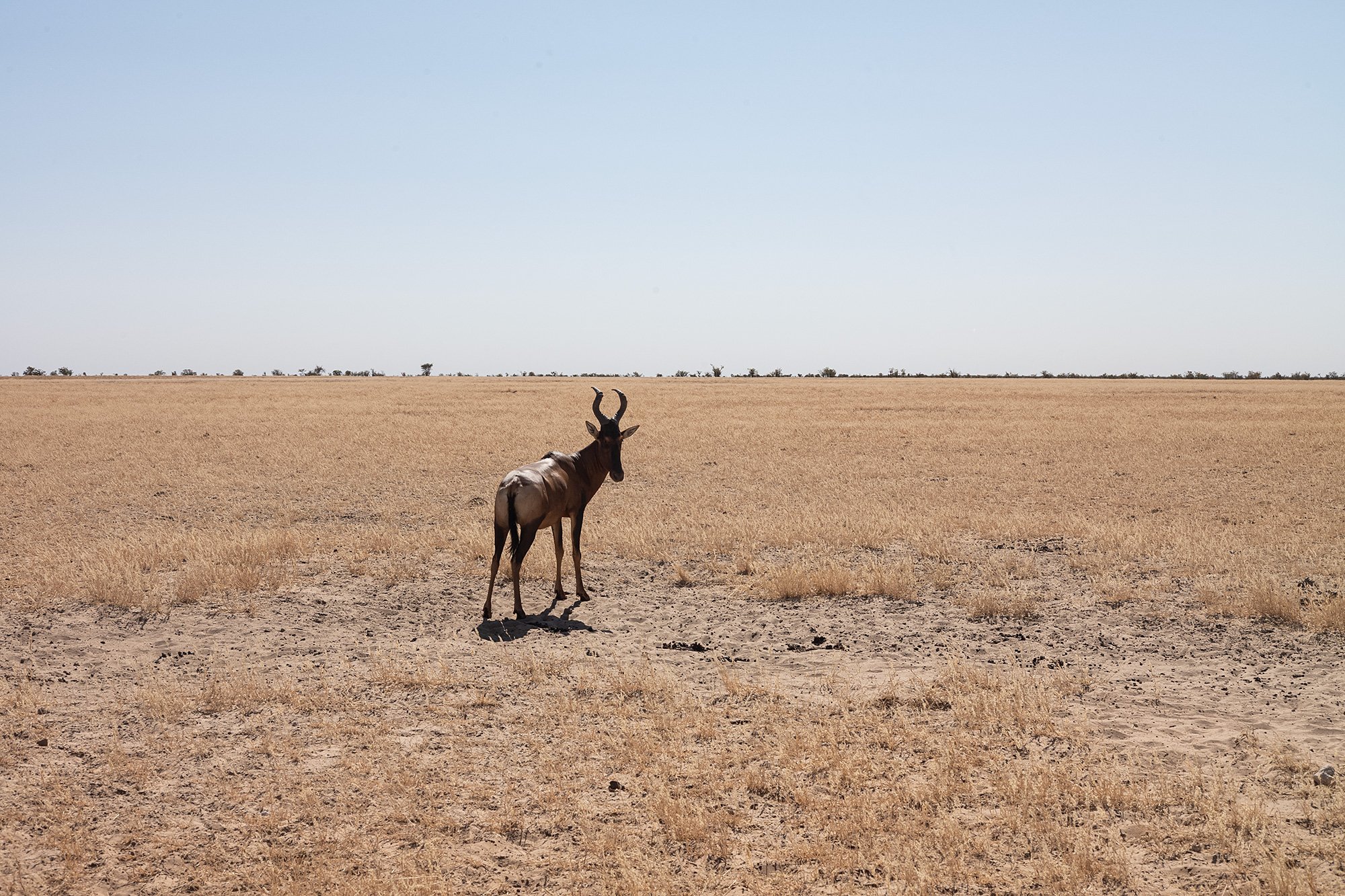
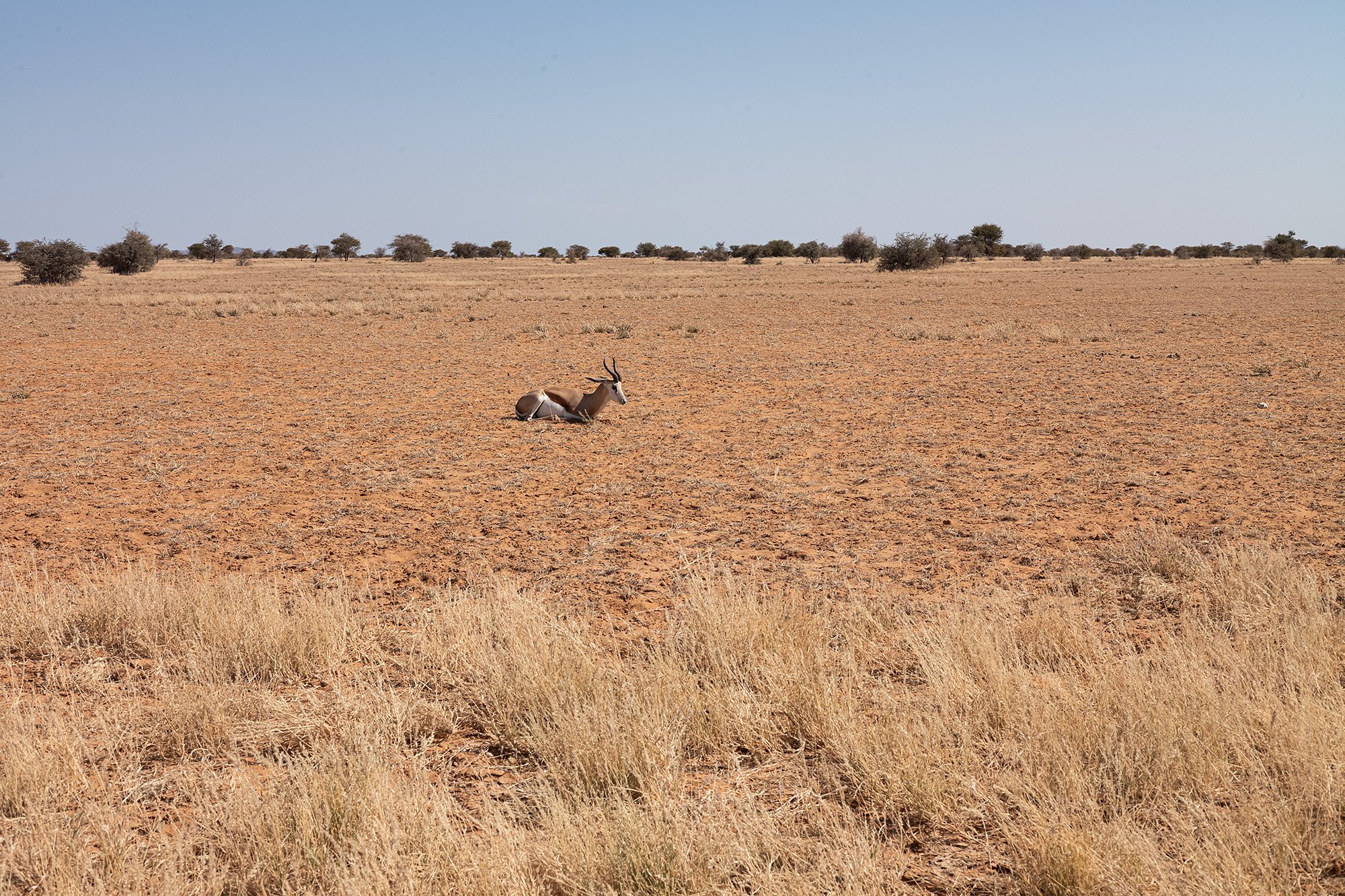

I pass a camp and stop to use the facilities. I don’t quite realize that I’ve reached this specific waterhole; the map is a little unclear. There’s a walkway to a small structure hovering over the landscape, but I’m searching for the Olifantsrus waterhole and decide to move on. I follow the road a bit further, doing my best to make sense of the map, and then decide to turn around and revisit the camp. On my way back to the camp I pass the French couple from Dolomite Camp. We wave to each other.
It turns out the camp is the waterhole I was looking for. The structure contains a blind. I climb the walkway to the hut and walk down the stairs to the viewing floor. A couple plays Bananagrams or something that looks like it on a concrete dias. Wildebeest and zebra are taking advantage of the waterhole and I watch as they approach and drink in front of me, separated by a single pane of glass.
I climb to the second floor and look out over the waterhole as the animals finish and begin to walk back into the bush. It’s an awesome feeling being so close and wish I had the time to spend an entire day in front of the hole in hopes of seeing more.

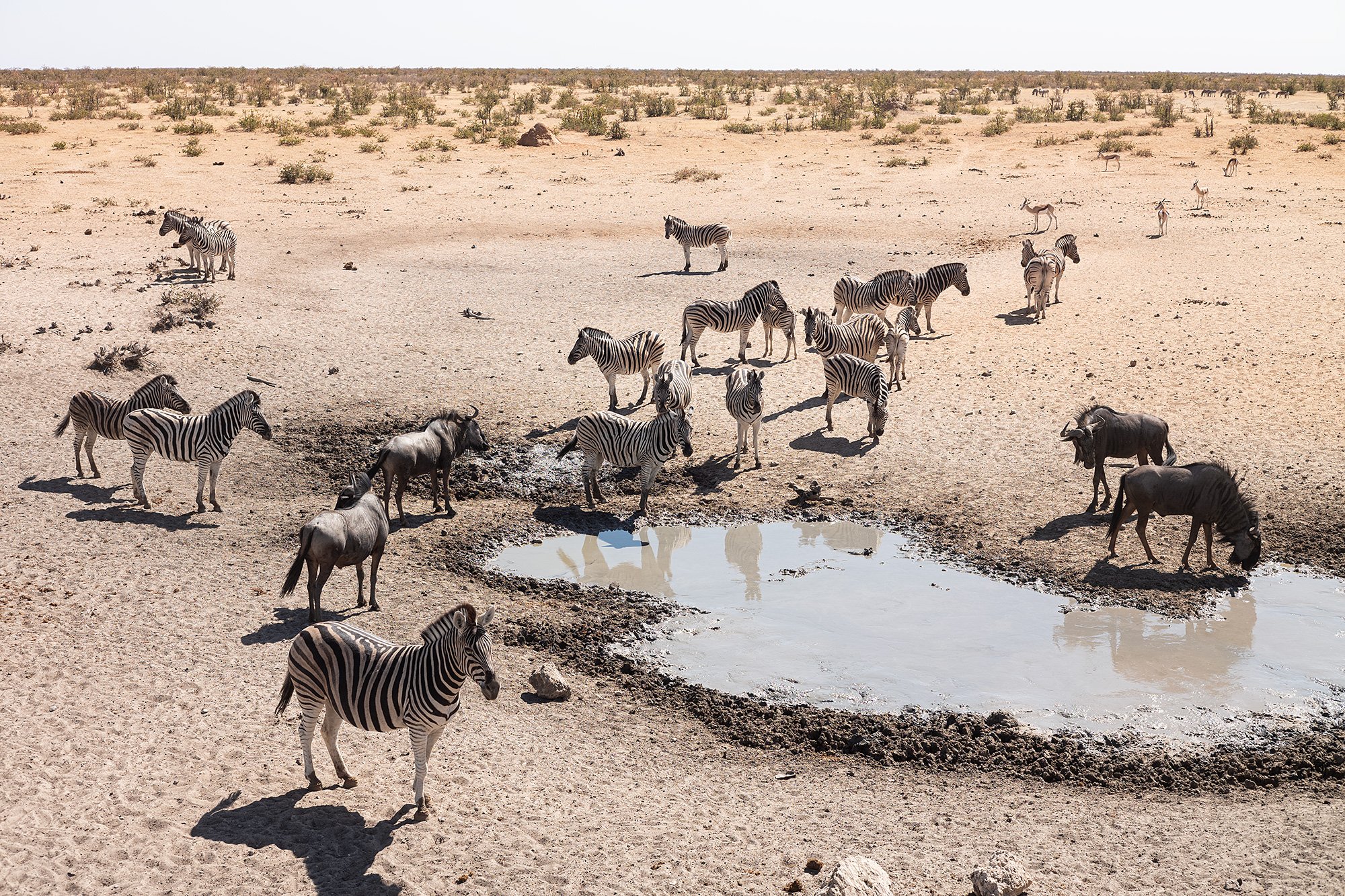

I drive past Tobiroen, Teéspoed, Bitterwater, and Duiwelsvuur, pulling into some and passing others when I can see that they’re unpopulated. Now and again I pass the odd animal on the side of the road.
I turn into Sonderkop to find a single automobile parked by the waterhole and a single giraffe. The giraffe takes their time preparing to drink, making sure all is safe before they lower themselves to the water. Inside the car a couple eats their lunch.
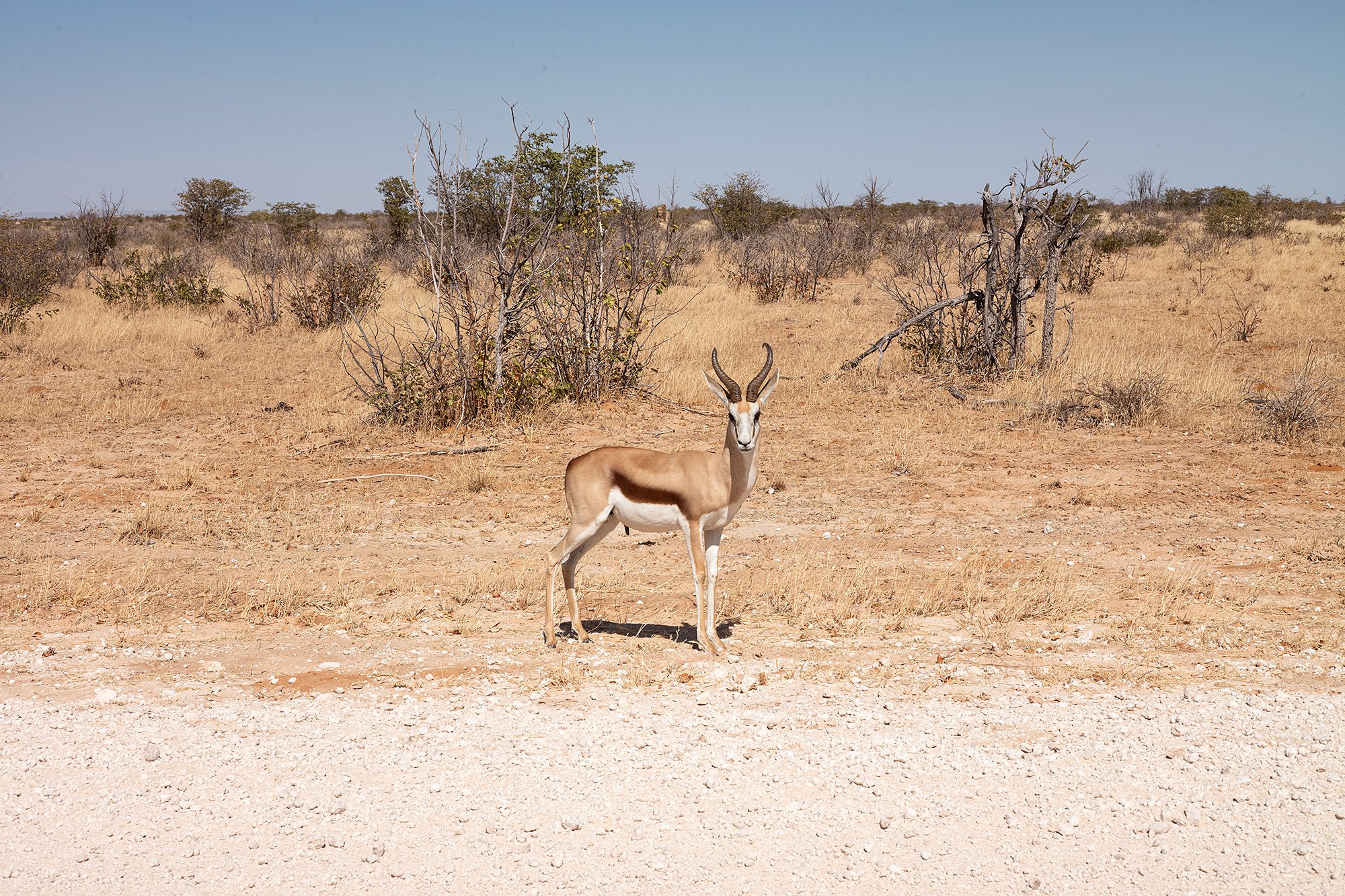
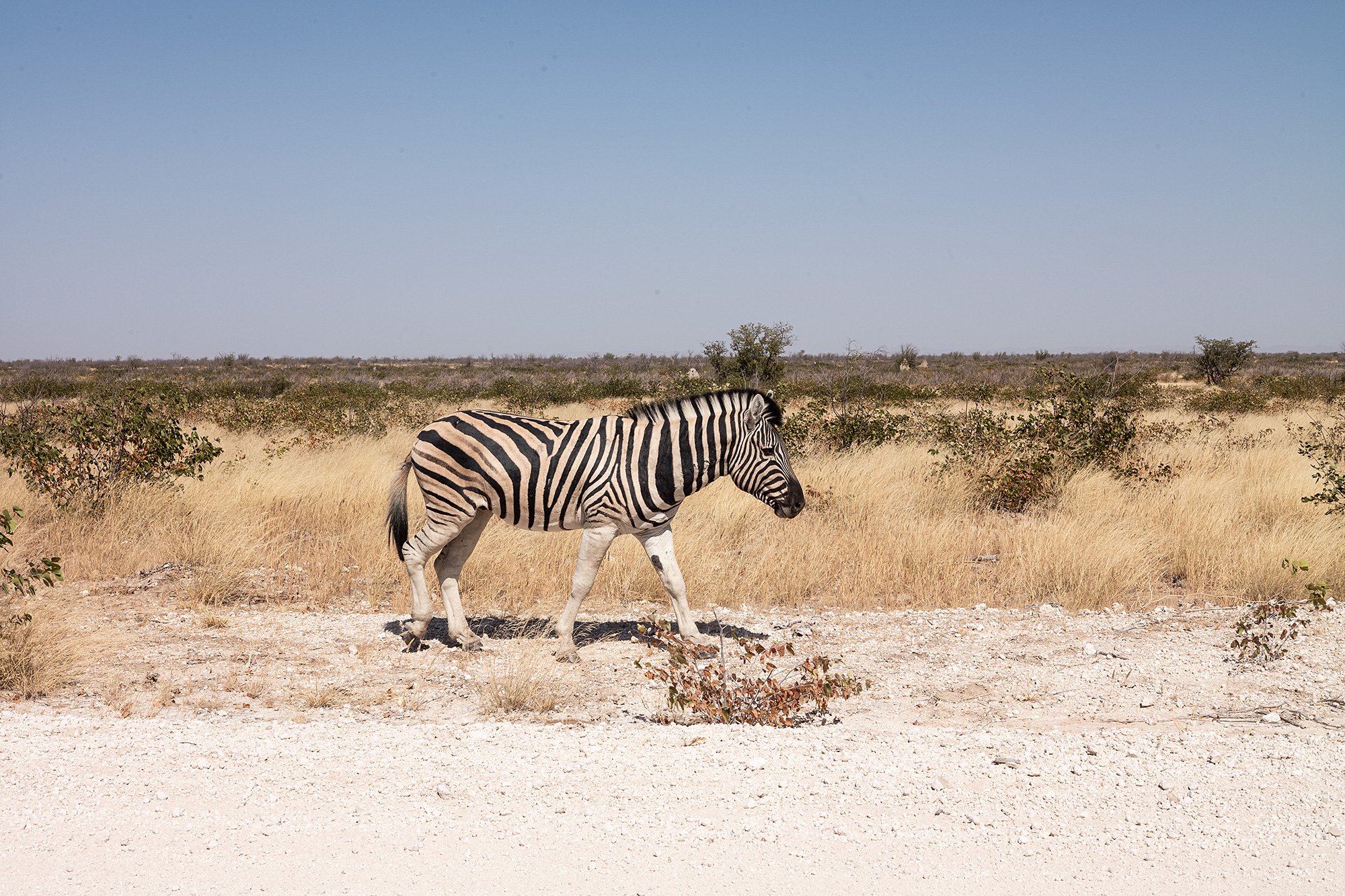

I stop at a few other waterholes on my way to Okaukuejo, watching animals walk to and from the oases that dot the plains.
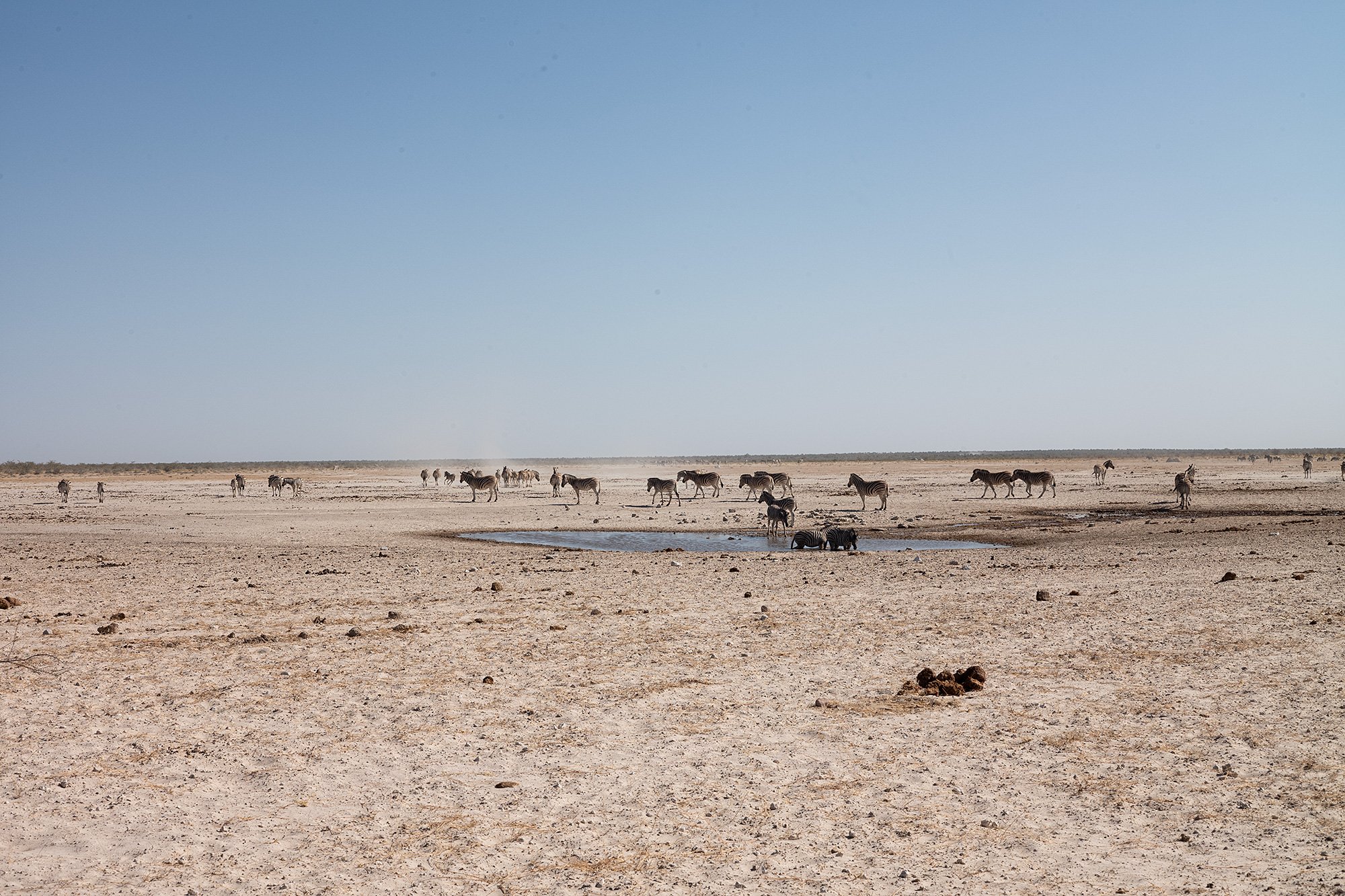

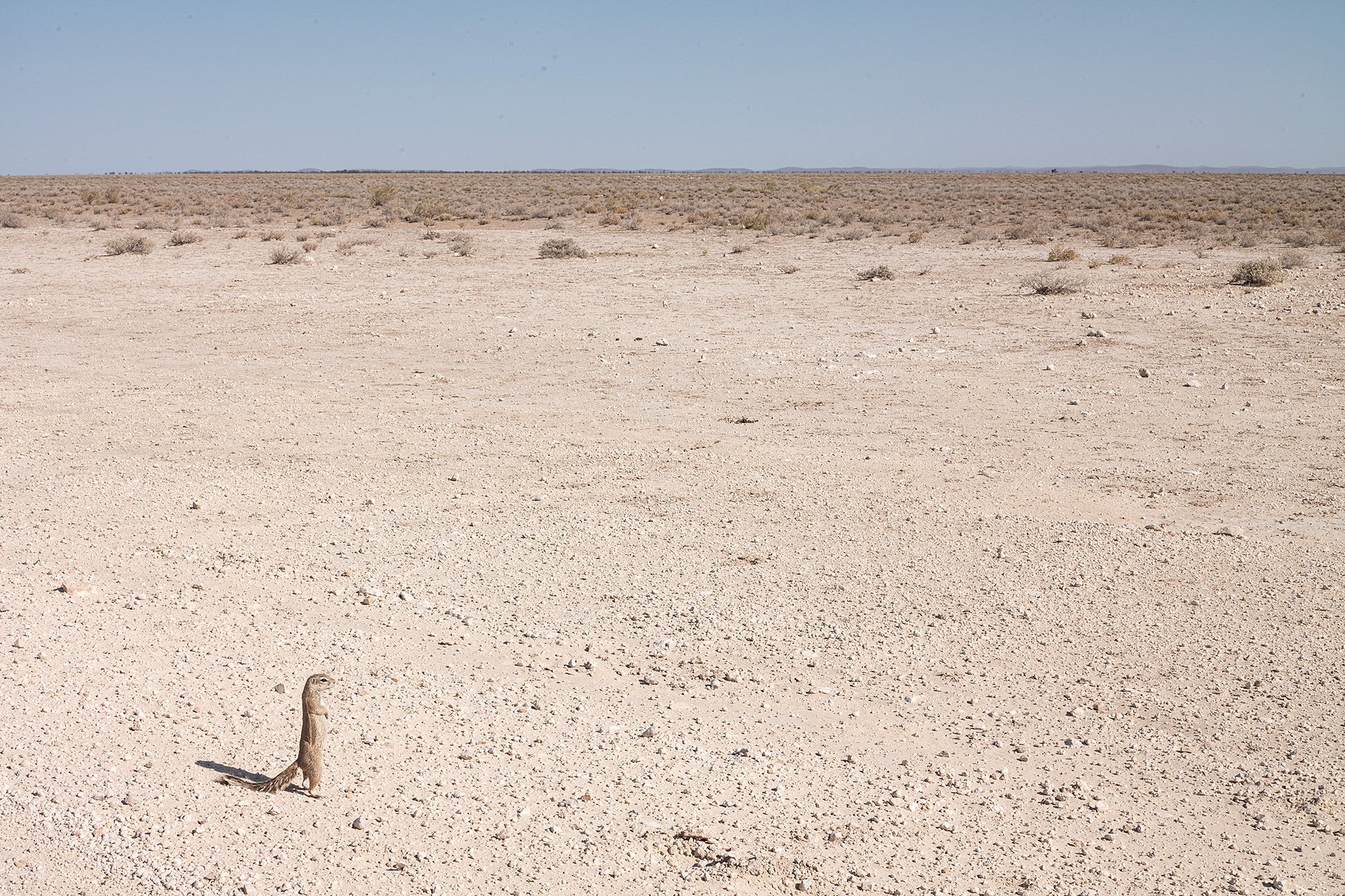
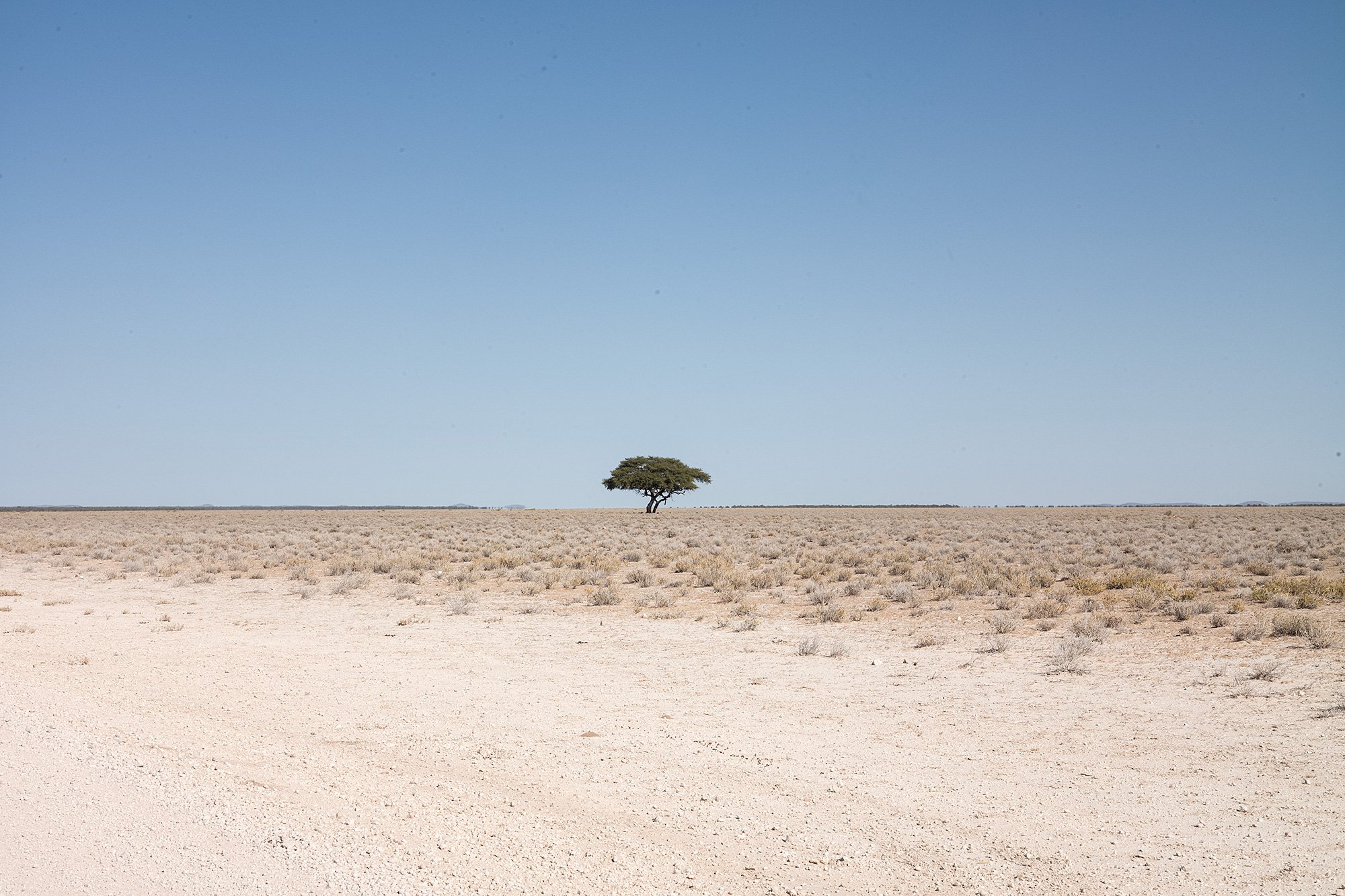
Nearing Okaukuejo, a loop road heads north. I check the time and decide to try and see one or two of the waterholes, if not all of them. It’s a dry, dusty road, and at one point I feel the truck start to sink into the sand. I give it more gas and make sure I power through the section before getting stuck.
Along the way I see a few springbok, but the detour this afternoon isn’t really worth the effort and I’m eager to get to camp. I’ve been driving around seven hours, and the entrance to the camp will be closing in ninety minutes.

O n the main road to Okaukuejo I pass a pair of giraffe and stop to watch them feed. They stop to at me when I stop, but soon turn back to their dinner.
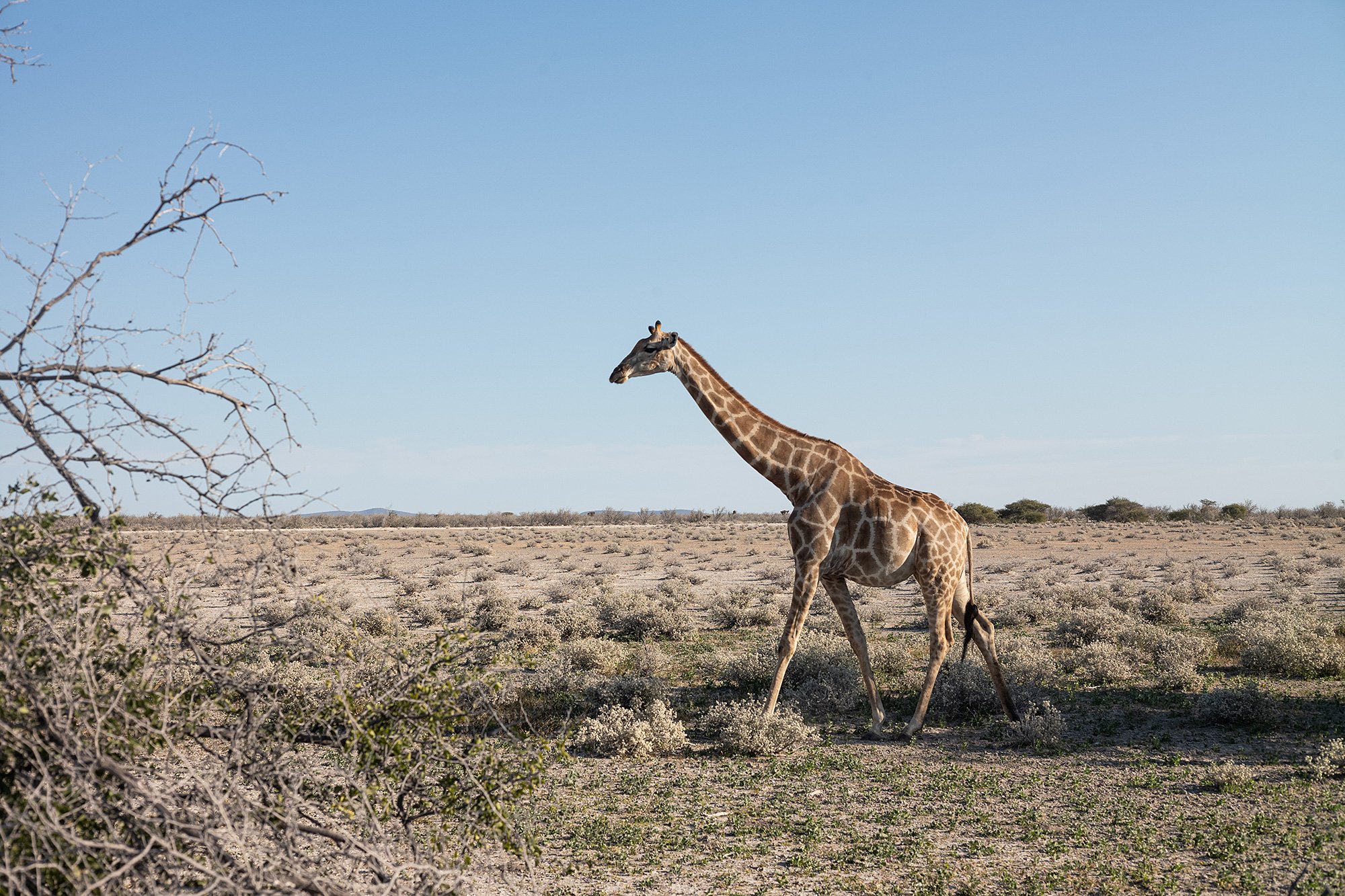
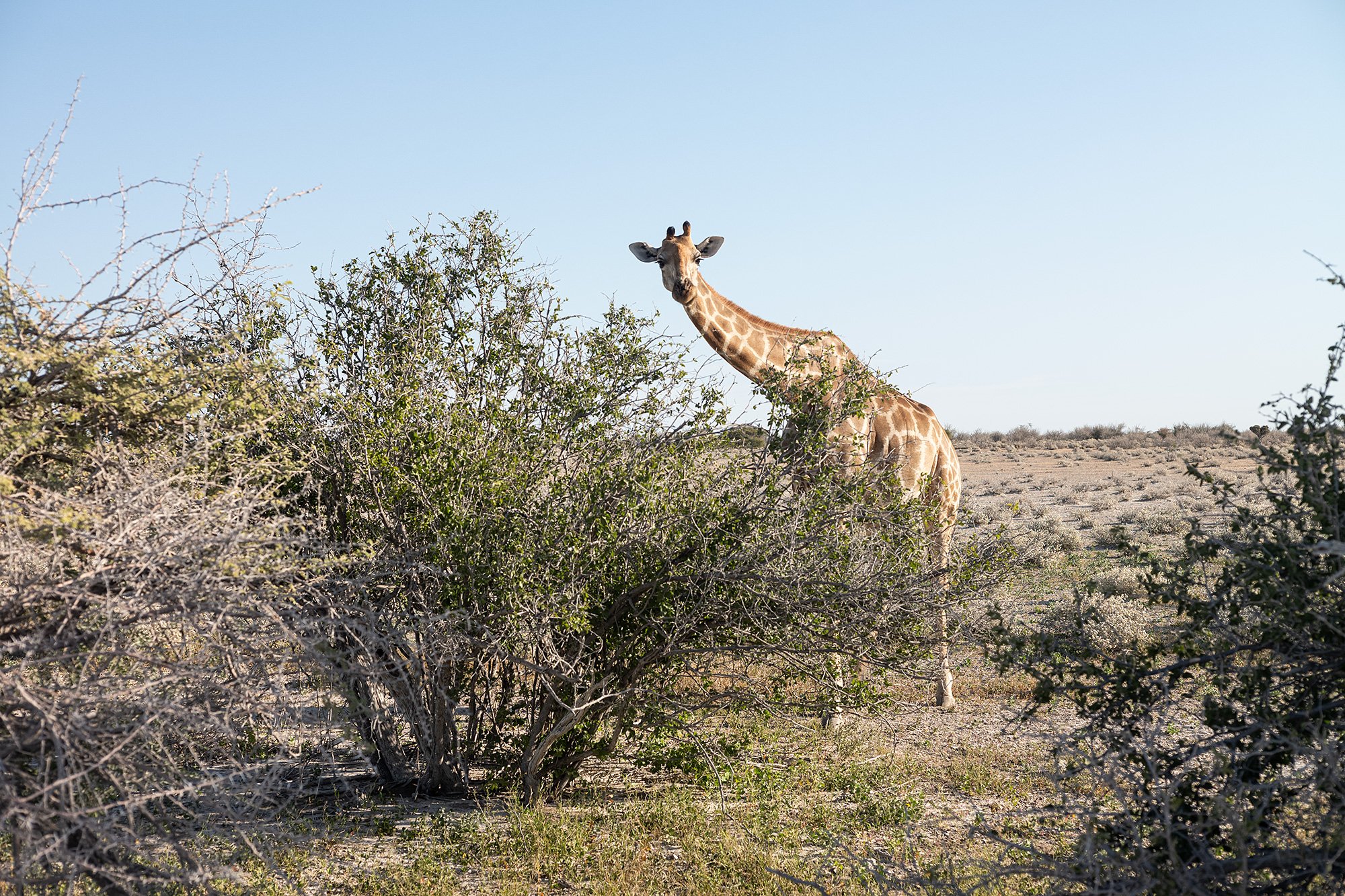

It’s less than thirty minutes to camp and I drive leisurely across the plains. I know I’ll make it in time and no longer feel the need to rush.
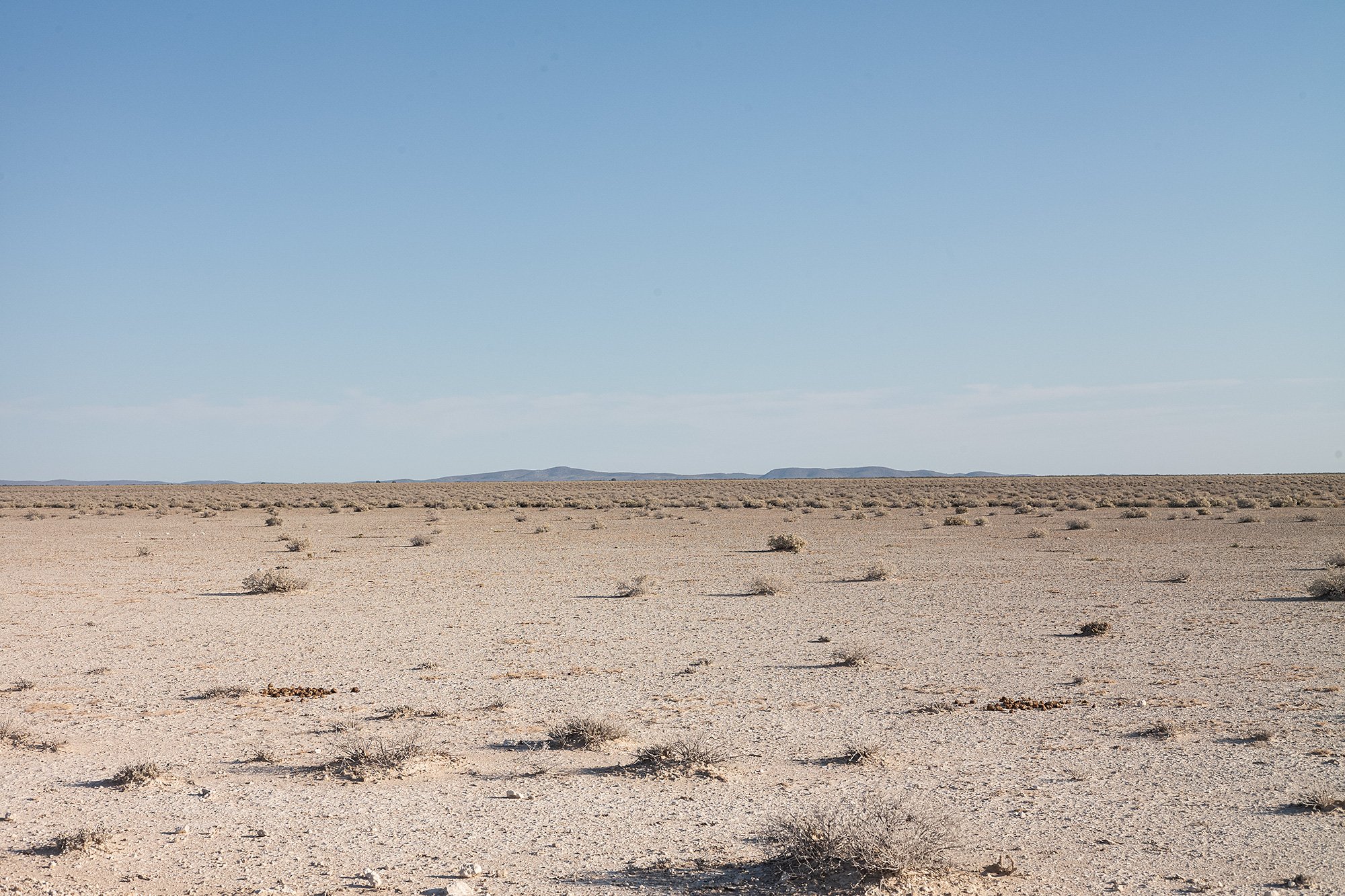
Okaukuejo is more than a camp; it’s practically a small town with a post office, a general store, and gas station. The camp itself sprawls over the walled-off area, with campsites, huts, lodges, and a restaurant and pool-side bar. A stone tower near reception offers sweeping views of the camp and the surroundings.
I check in at the front desk and am given a map. I’ve booked a waterhole chalet on the other side of the compound and they show me how to get there, where to park. The gas station is en route. They tell me about dinner and suggest I make a reservation before I head to my chalet. I thank them and head to the restaurant to secure a dinner time and then drive to my chalet.
I unpack the car into the chalet and then walk to the waterhole. A stone wall encircles part of it; benches are set up for guests to admire the view. A small set of covered bleachers anchor the edge of the compound. A single oryx stands ankle-deep in the water, sipping as it wanders around the perimeter.
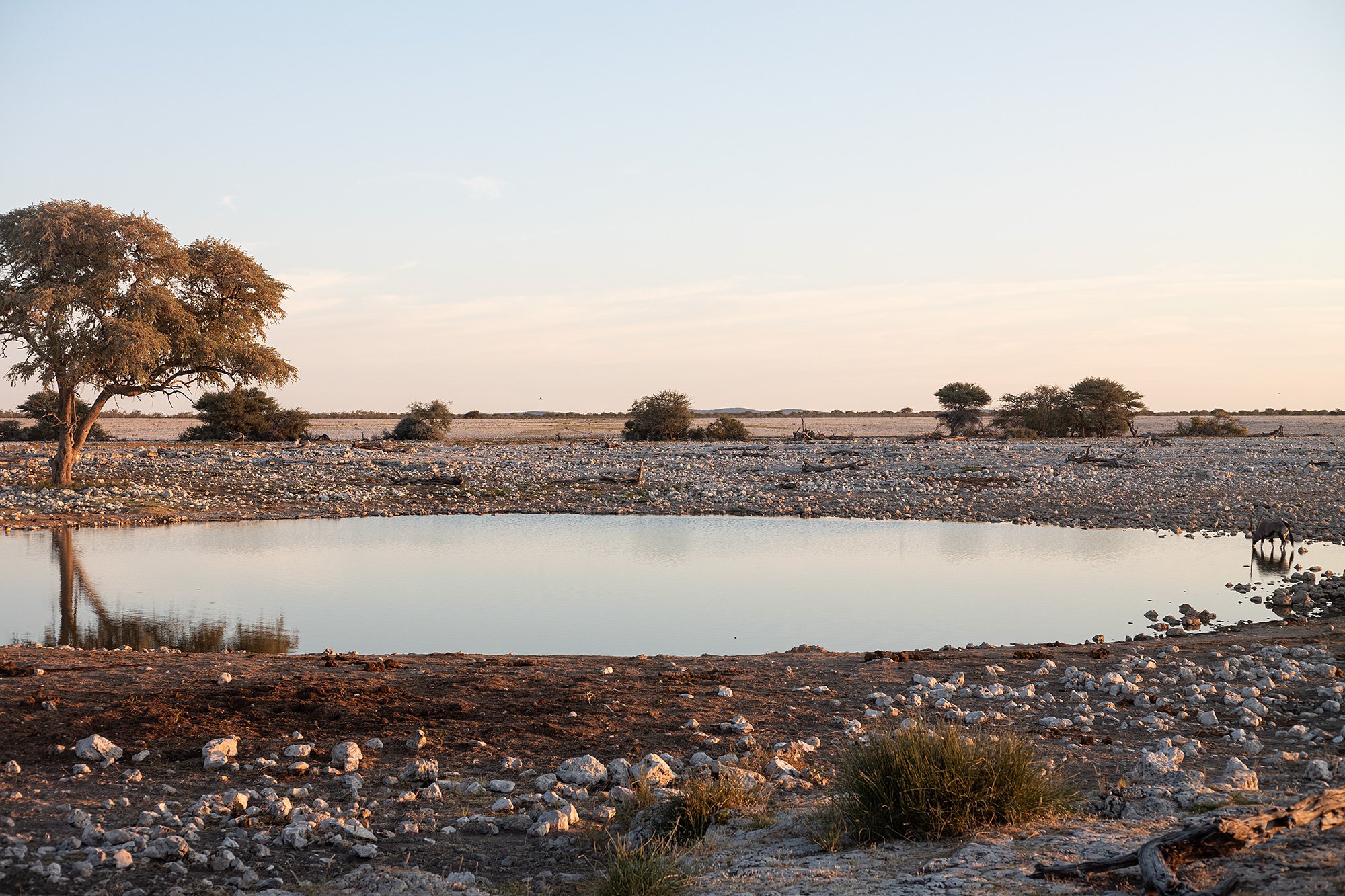
I sit on one of the benches, the sun setting to my right. I think back over the day and all that I’ve seen and done. I lament that I’ve seen only one elephant today, the bull by the side of the road soon after leaving camp this morning, though I am thankful for the elephants I had seen the day before.
My mind casts back further, over the past month and the beginning of this road trip around Namibia I am on. I think back on the apprehensions that I had before embarking, the excitement, the pre-planning, the adjustments I’ve made. I’ll be back to Windhoek in two days and this trip I’d been looking forward to for so long will have concluded. It’s been better than I could ever have imagined.
I’m caught in reverie when I feel the people around me stir. A group of large lumbering animals has appeared on the horizon, approaching with the dusk. A hush falls over the viewing area as they come close and reveal themselves. It’s a large herd of elephants, come to drink.
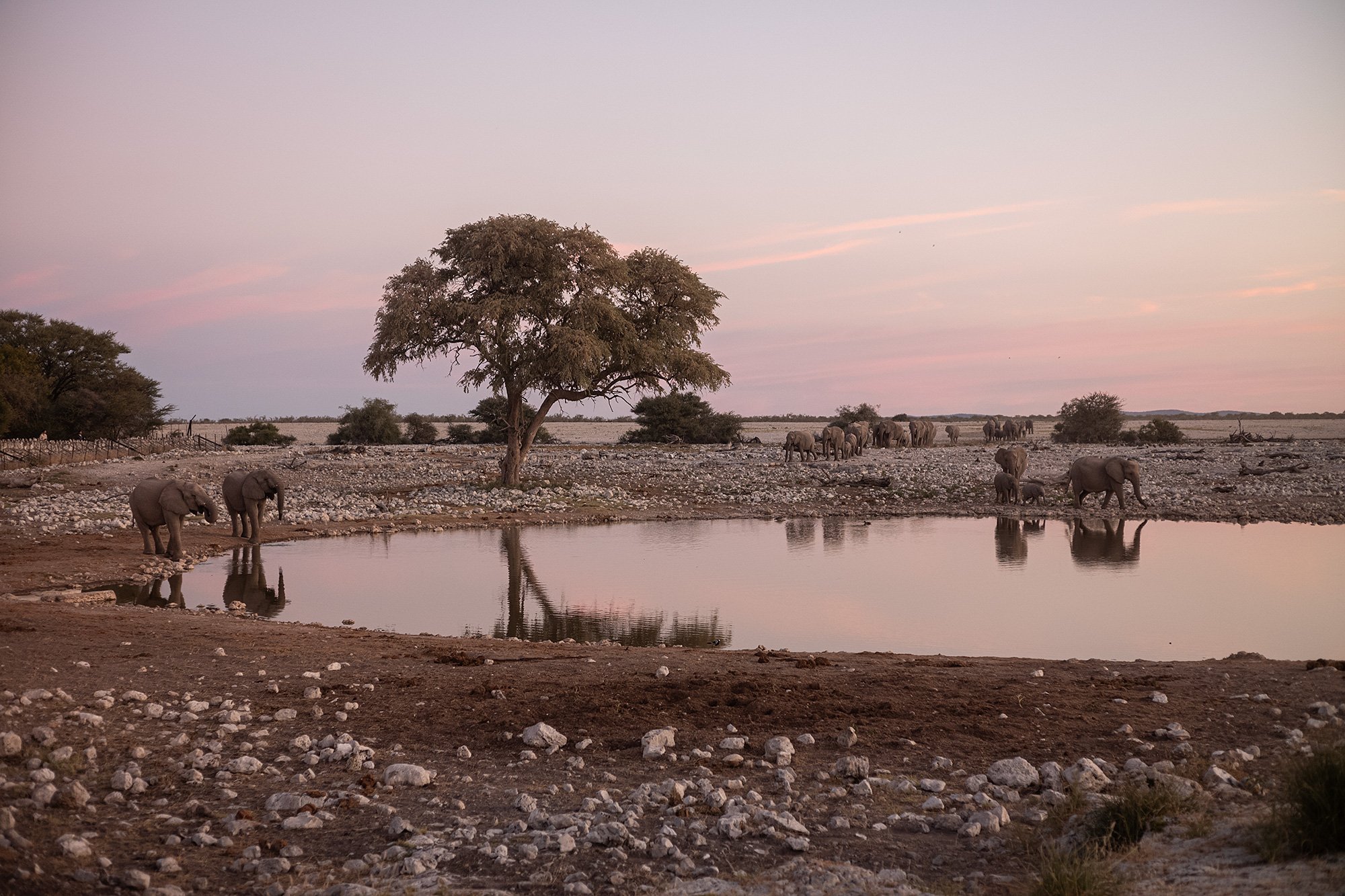
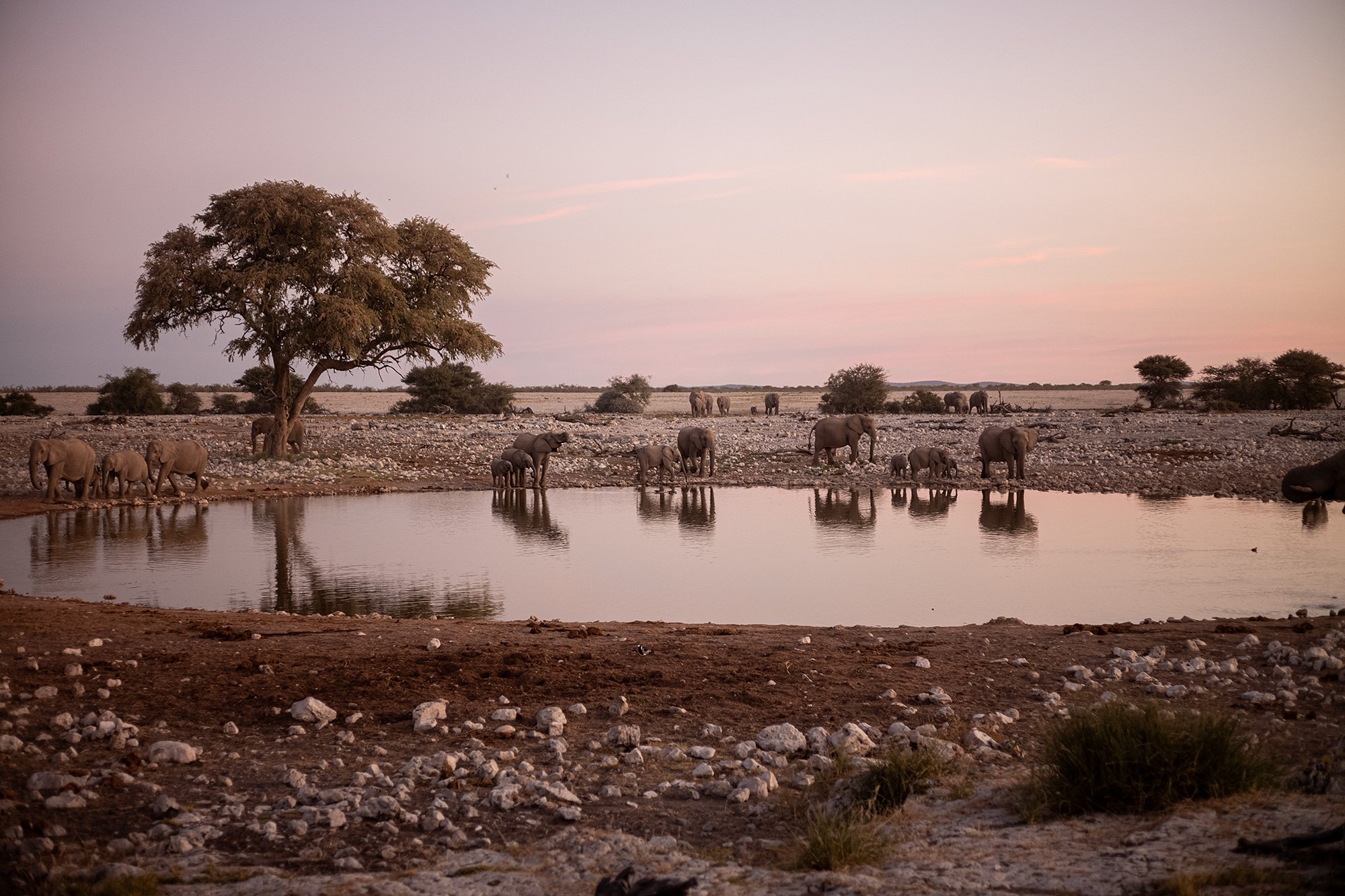

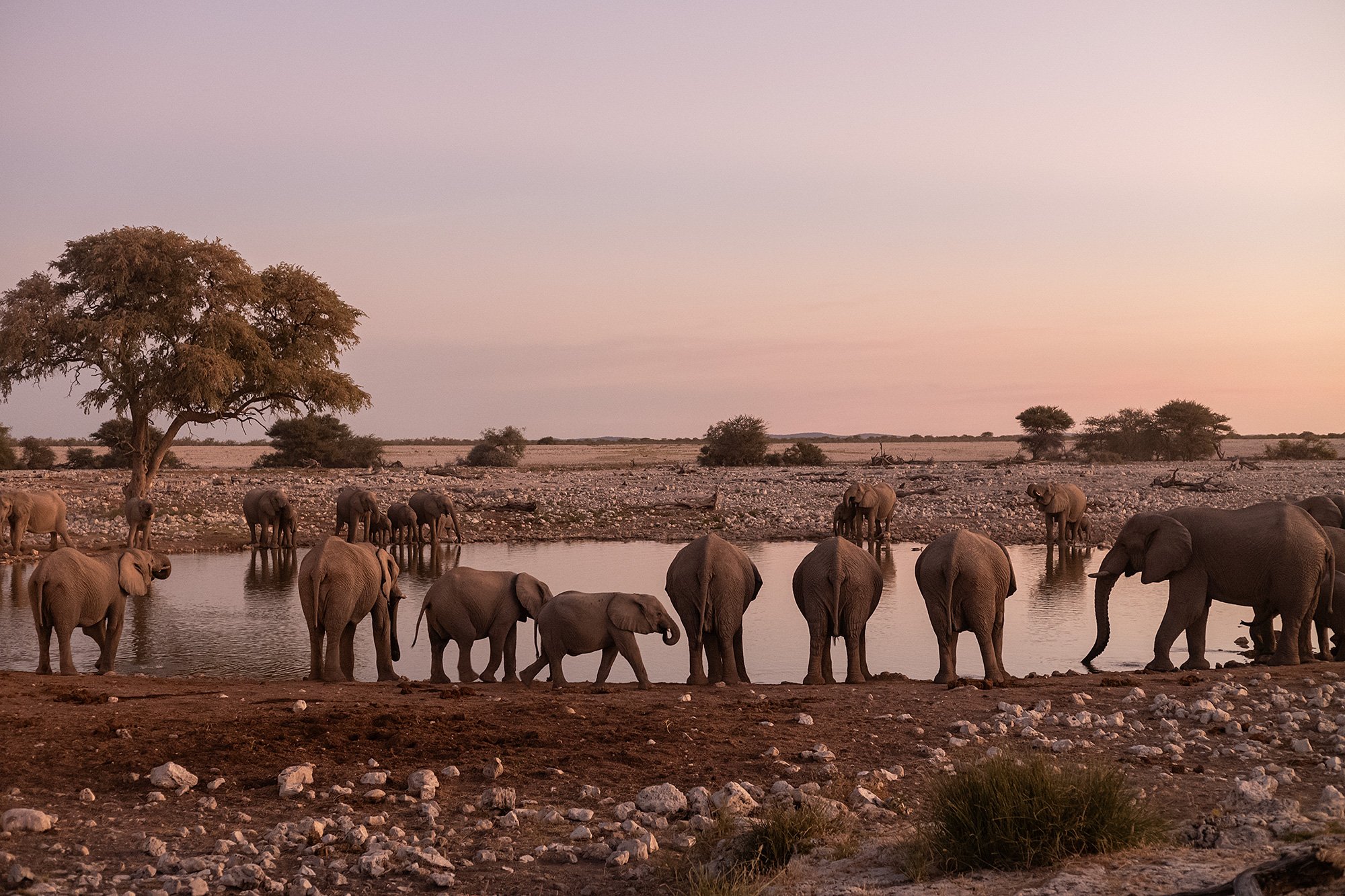
It’s an incredible sight. As the first herd surrounds the waterhole another herd approaches. There must be forty to fifty elephants at one point, bulls, cows, calves all sharing the waterhole. At one point two young bulls mock charge us where we sit. They make to rush towards the fence and then turn off to the side.
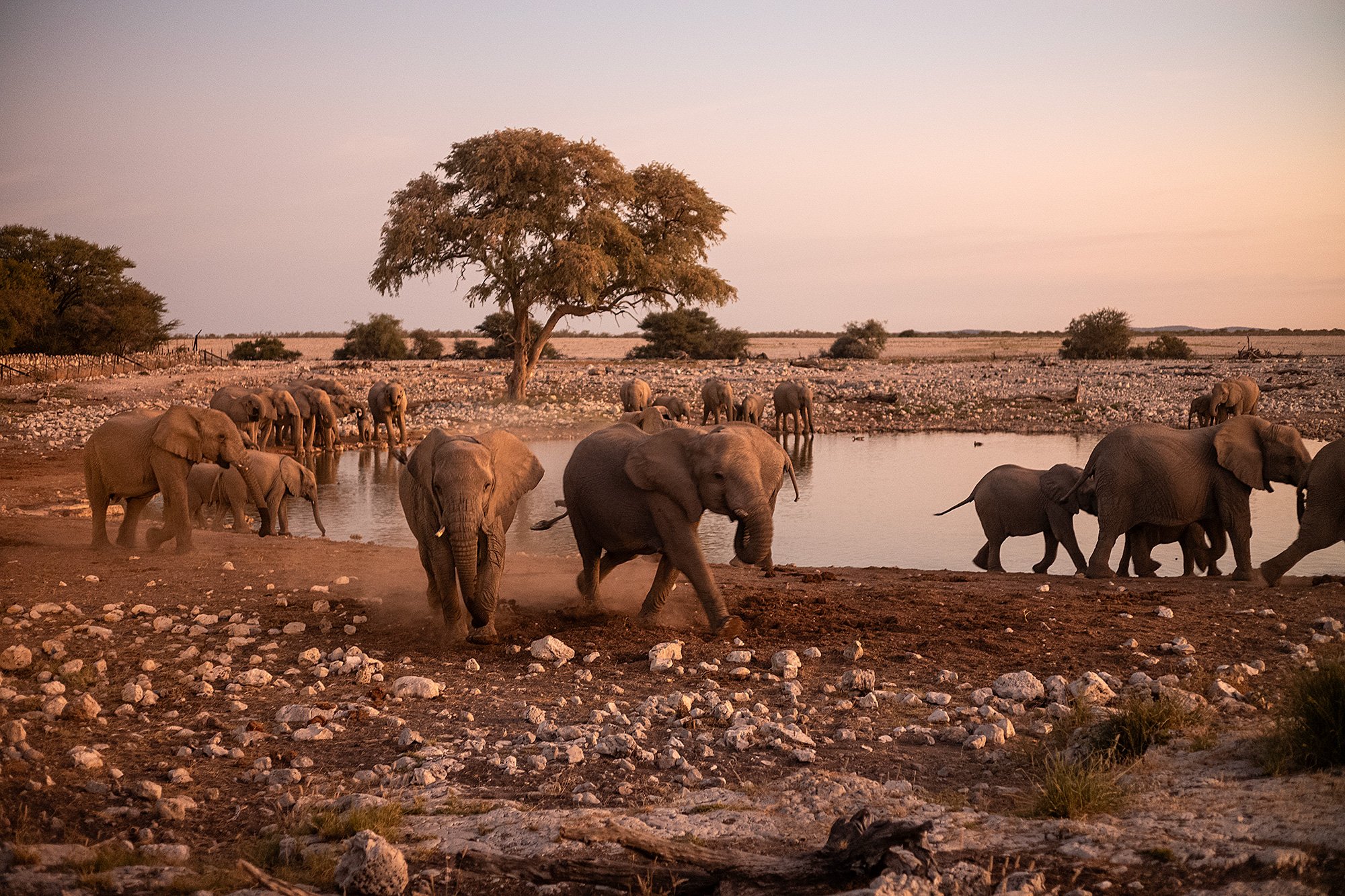
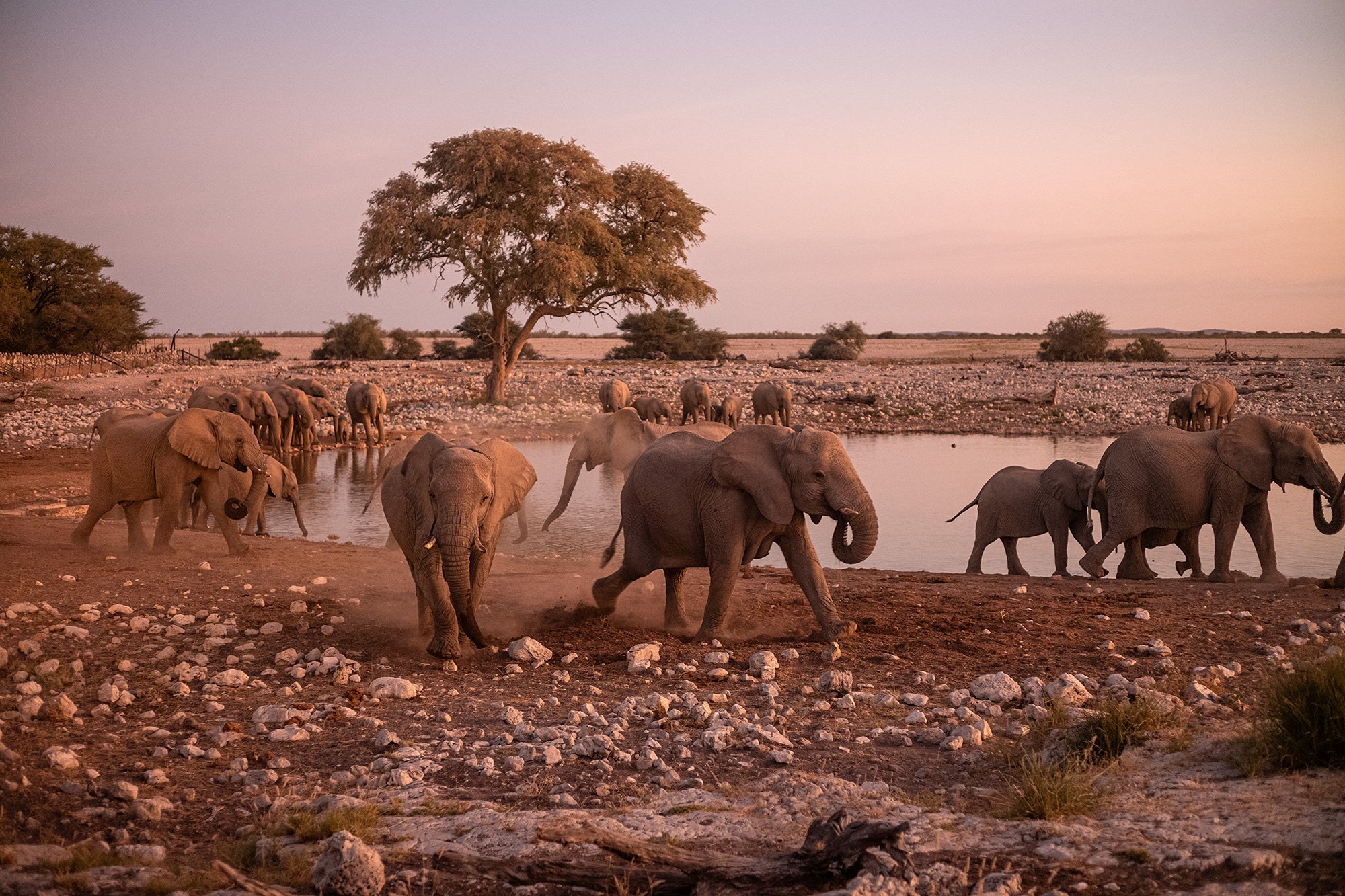
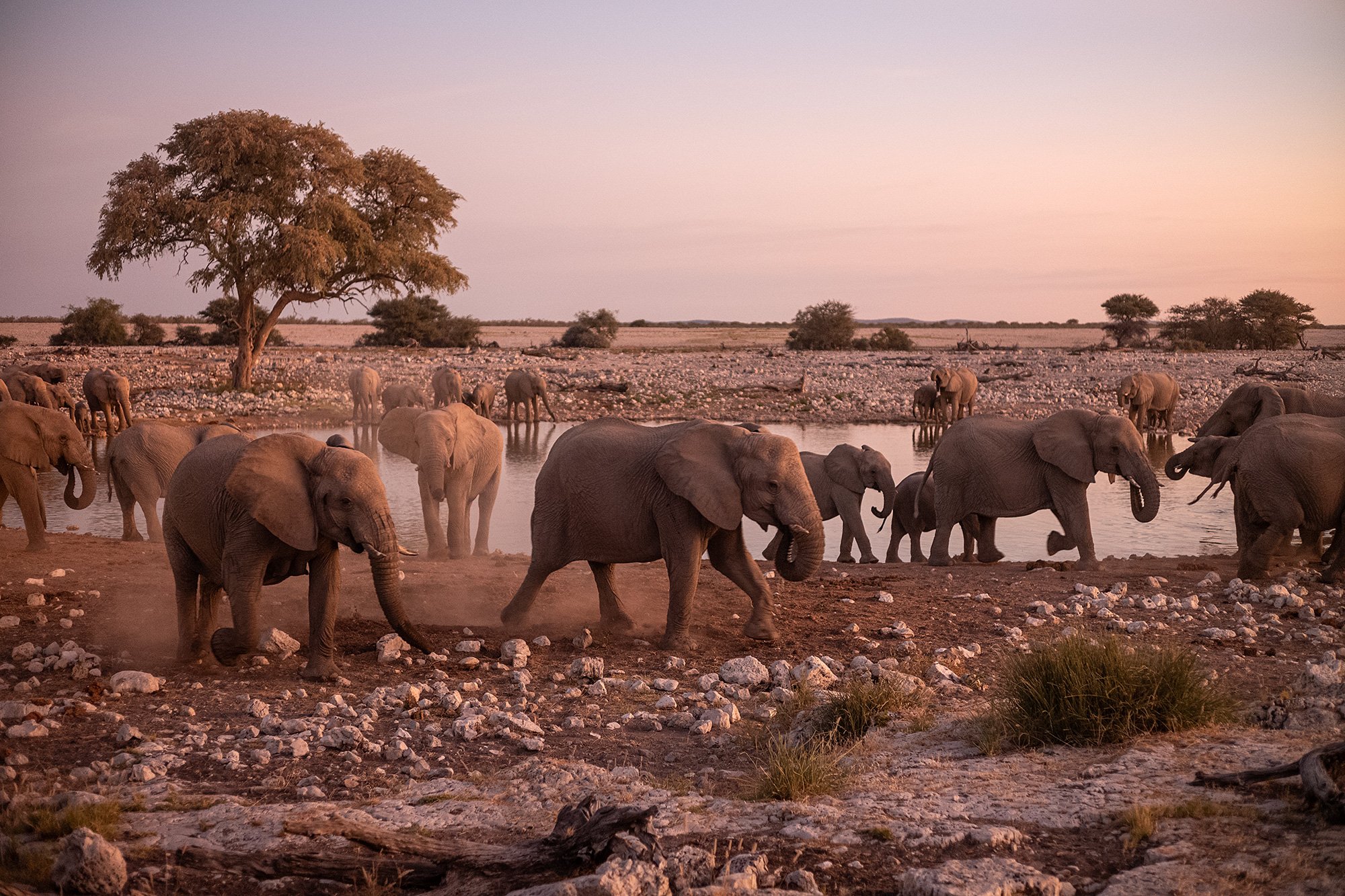
More elephants arrive and we watch as they greet each other, stroking and wrapping each other’s heads with their trunks.


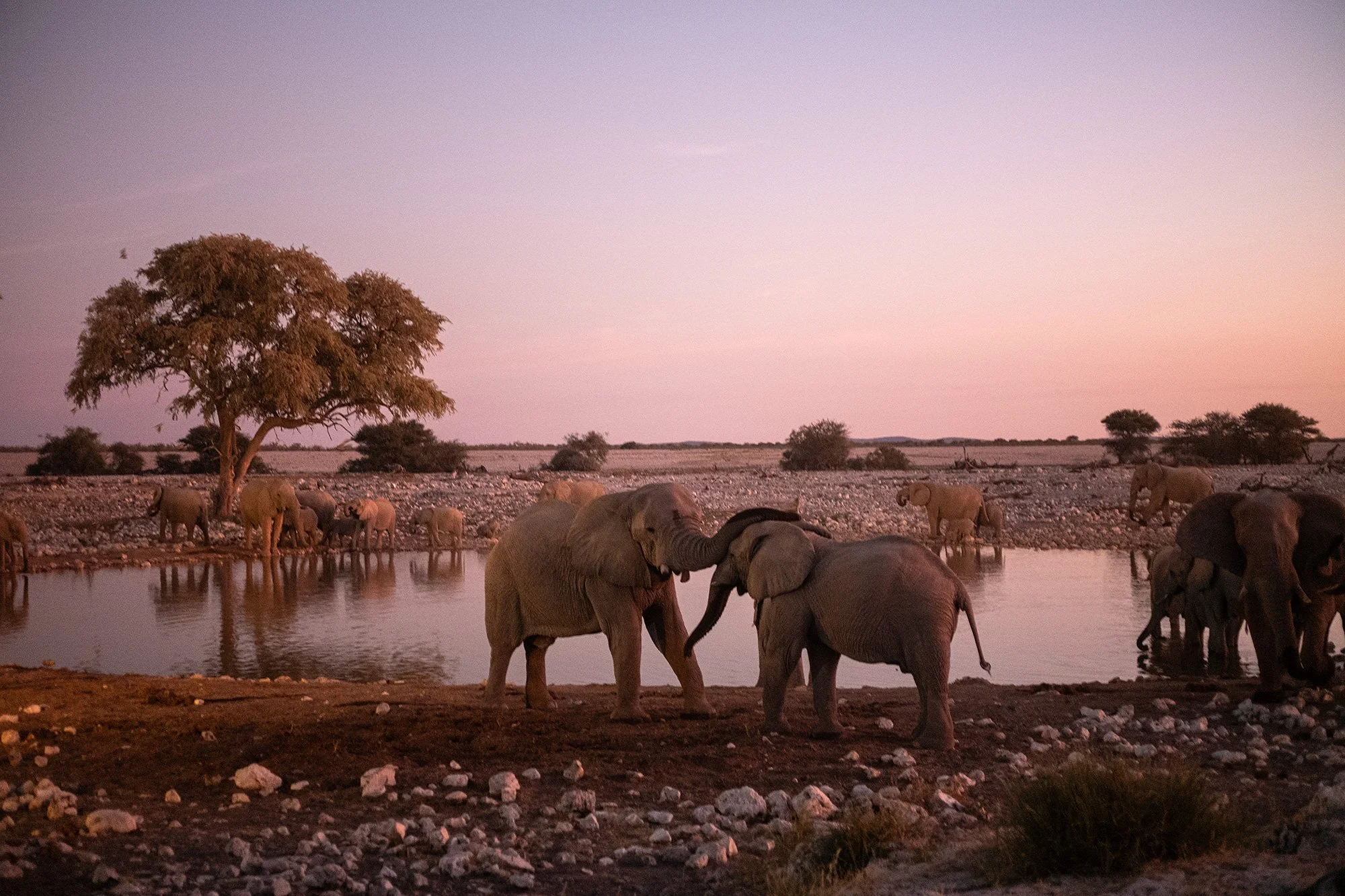
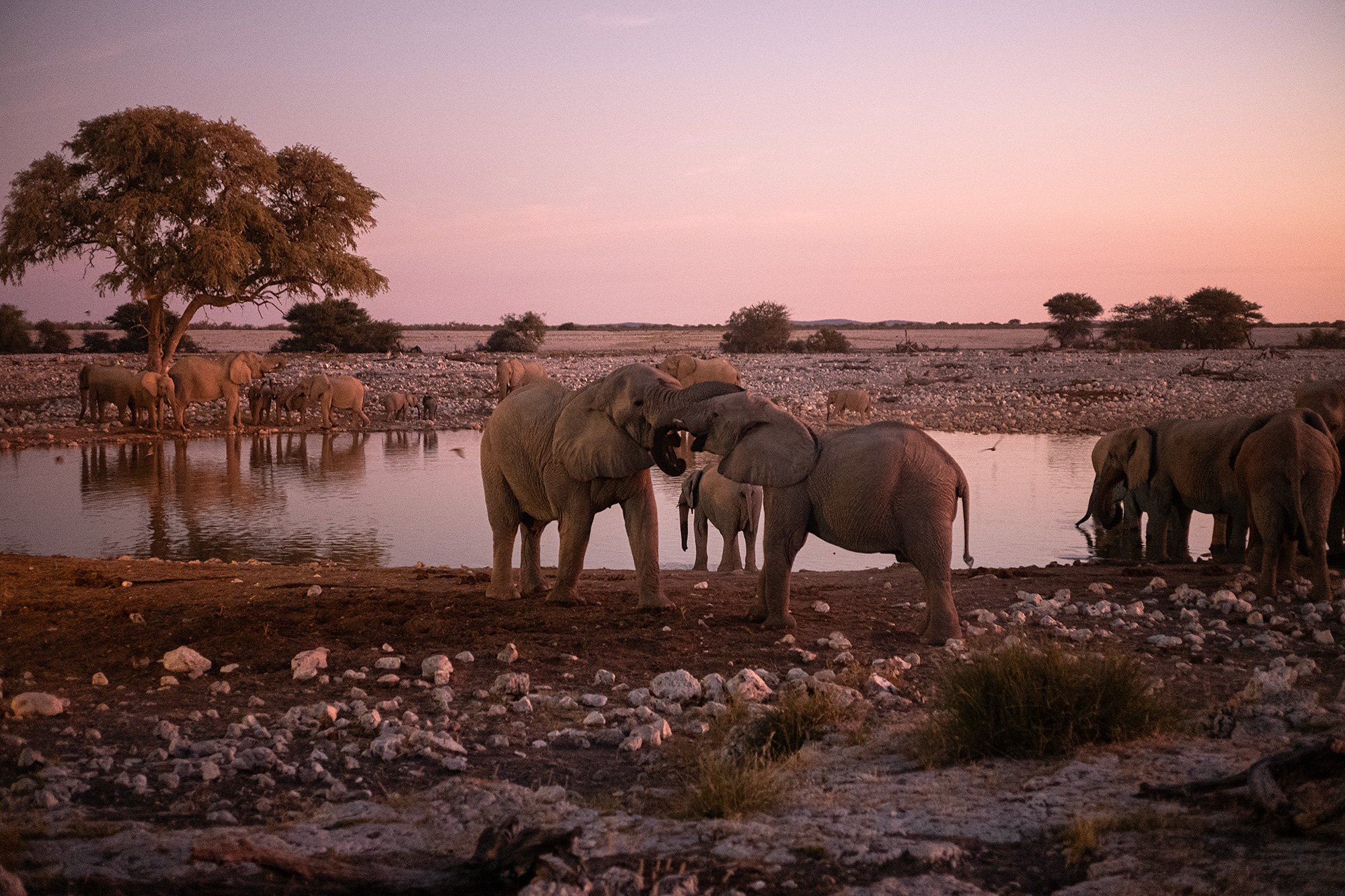
The sun sets and the floodlights come on. A crescent moon has risen in the sky and the elephants slowly start to peel off and head into the bush, disappearing as they reach the edge of the light.
I walk around the perimeter for alternate views. A woman from the UK is eating chips out of a bag, trying to keep as quiet as possible. She makes fun of herself, everyone out here quietly in awe of nature’s display and here I am crunching on chips.
I see the French couple sitting on a bench and stop to say hello. C’est incroyable, non? Oui.


It’s time for dinner and I depart the waterhole at the same time as another large group disappears into the night. A few rhino have appeared and a baby elephant circumambulates the pool towards it. The calf trumpets at them before running back around to join their family as they make they way slowly away from the hole and into the shroud of darkness that has descended around us.
I walk through the compound to the dining hall and find a table on the patio. It’s a busy night and the waitstaff is inundated with patrons. I wait patiently to order and make a mental note: if I’m ever headed back this way, it’d be better to self-cater inside the park.
After dinner I walk back to my chateau to don warmer clothes before heading back to the waterhole. A pair of rhinoceros and a giraffe have claimed it for themselves and I find a spot to sit and watch as they navigate the pool, an unbroken, unnarrated nature documentary spooling out in real time before me. 🇳🇦
8 June 2024
